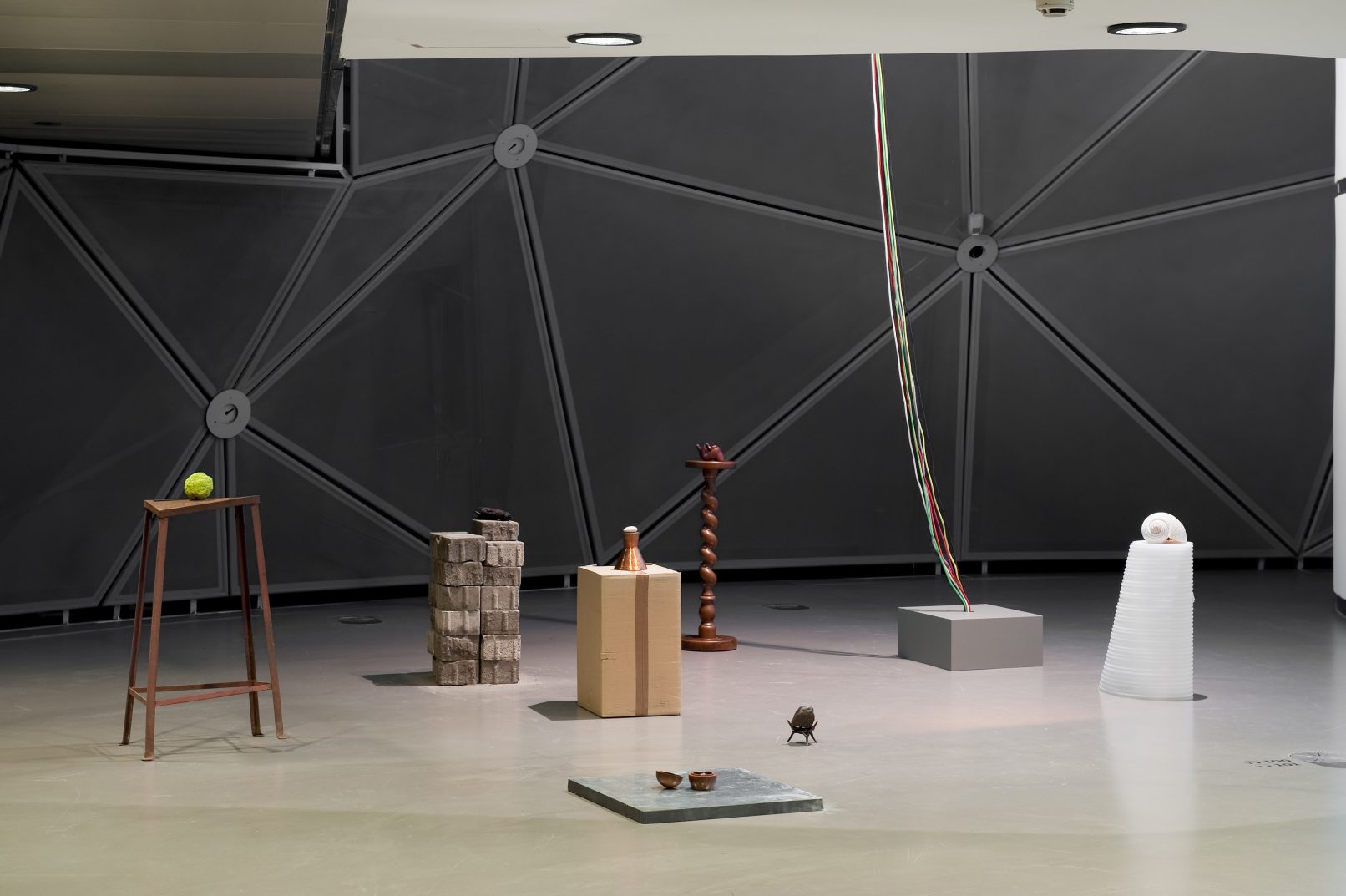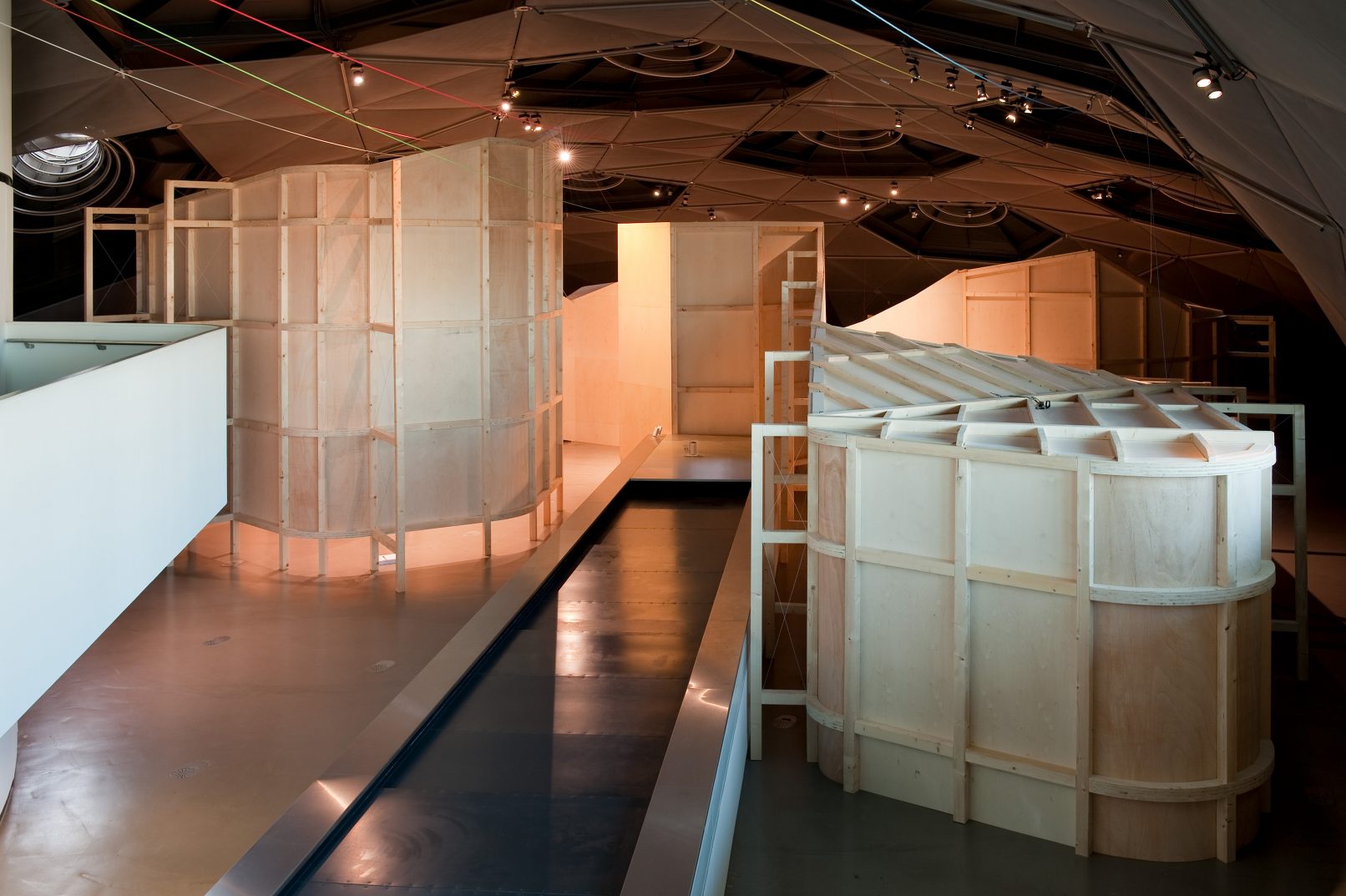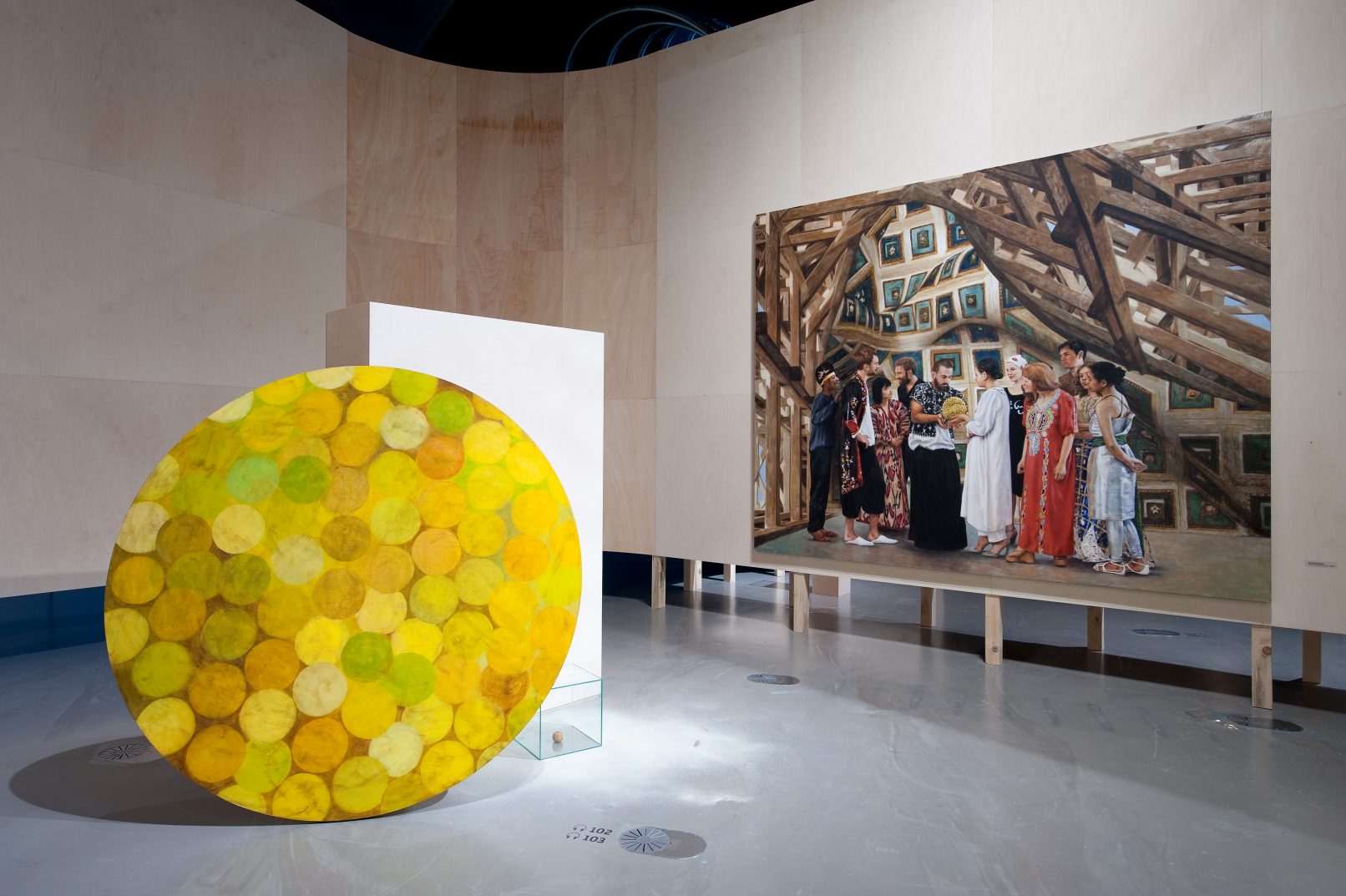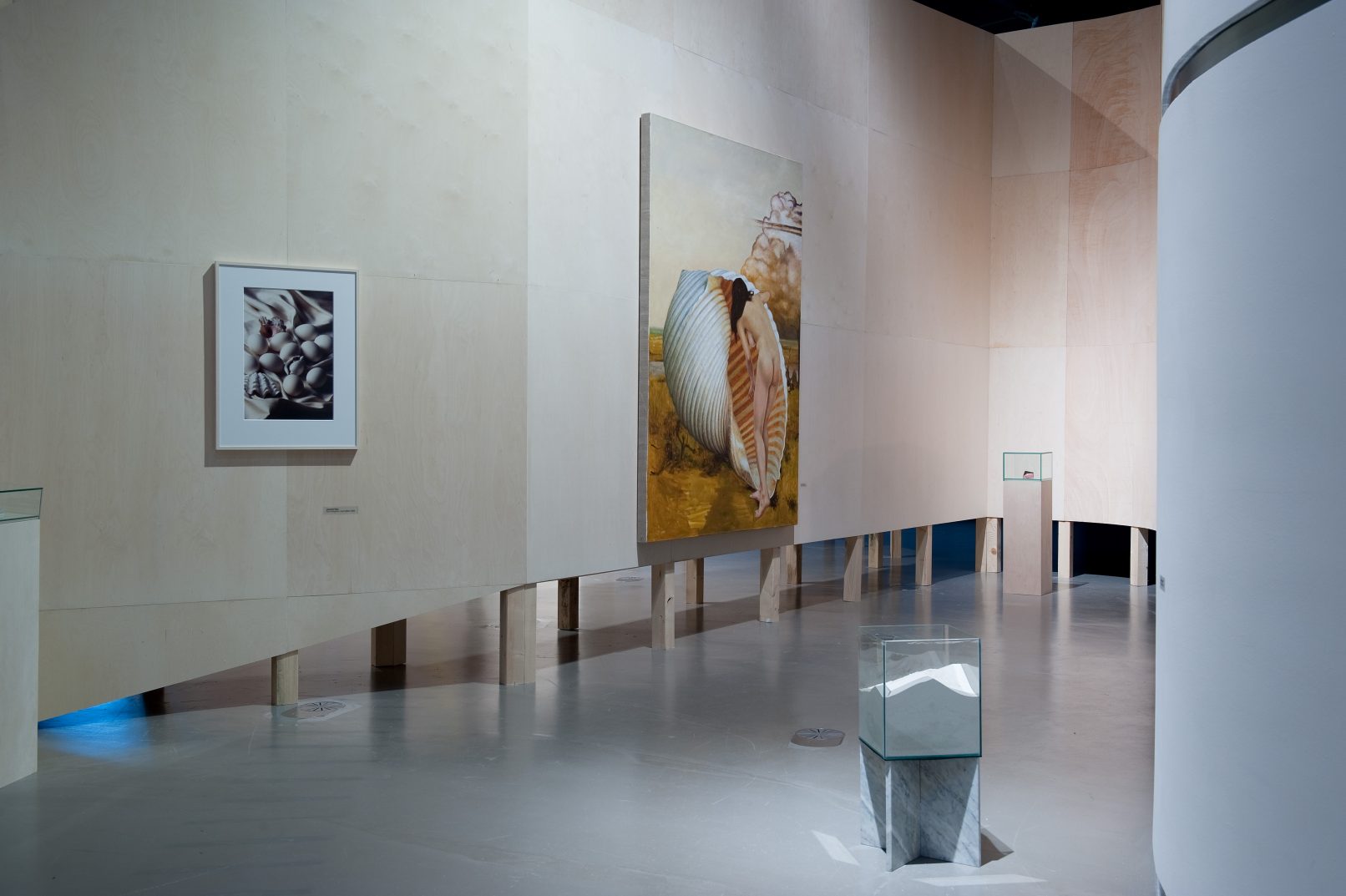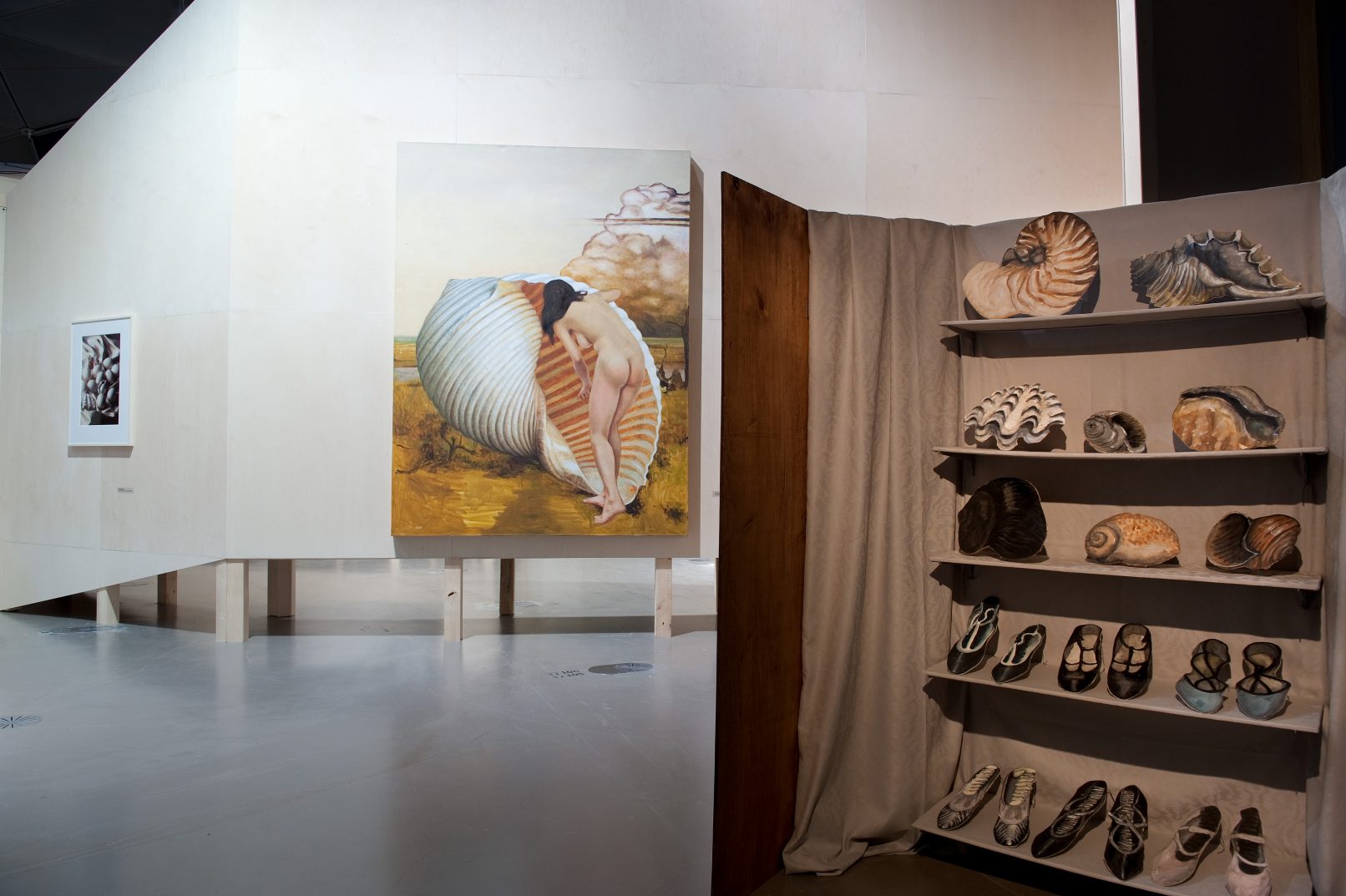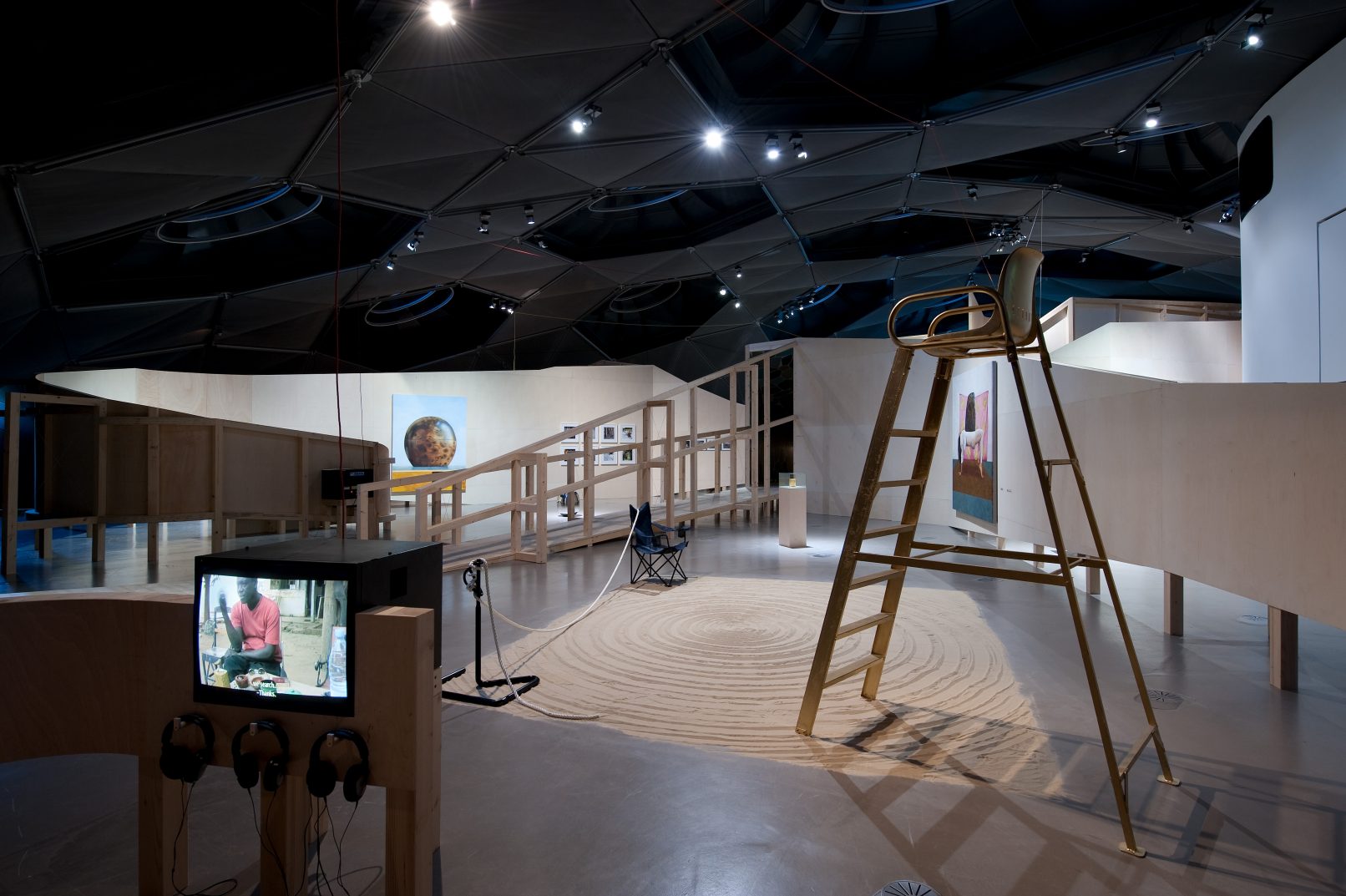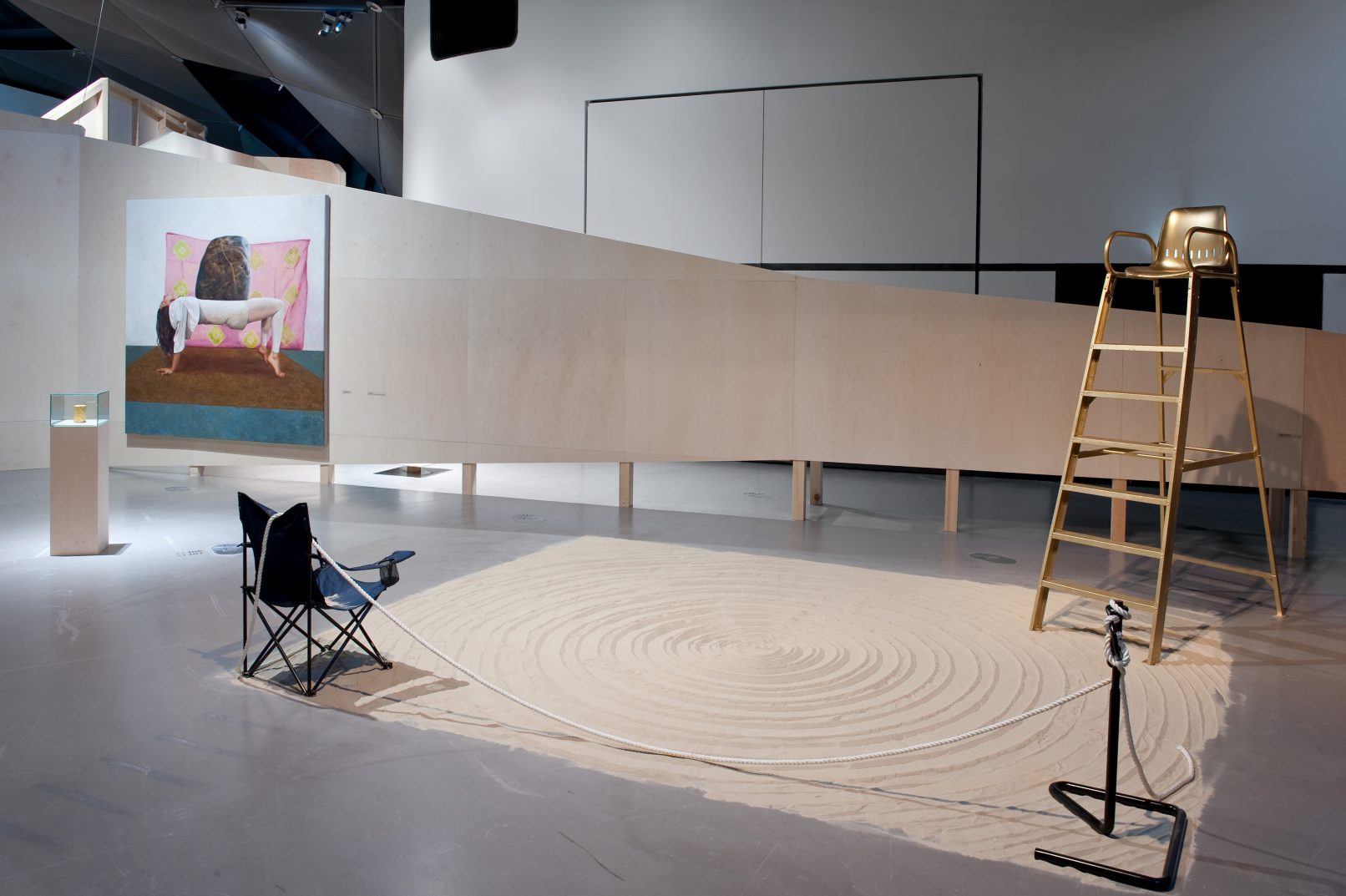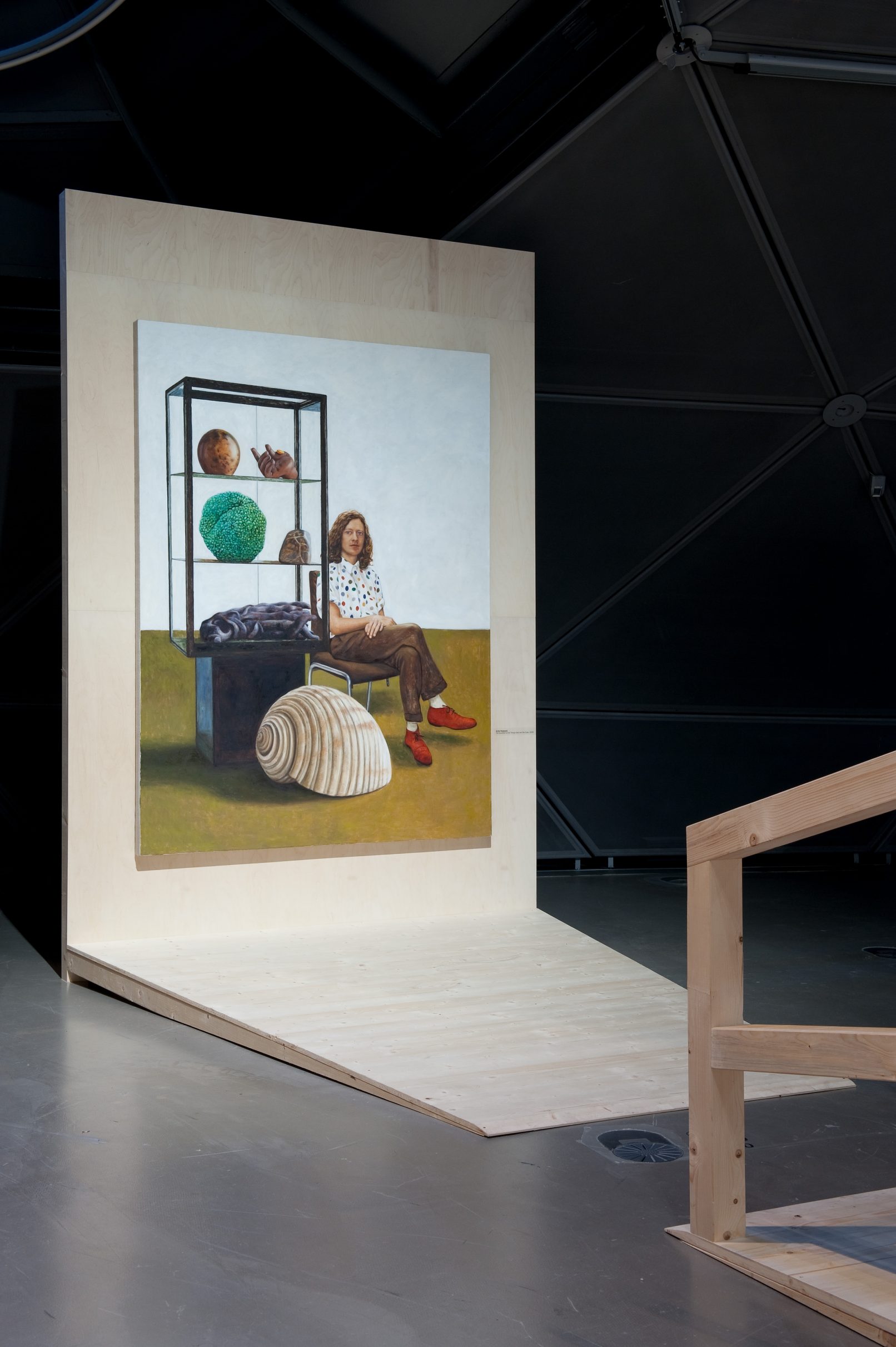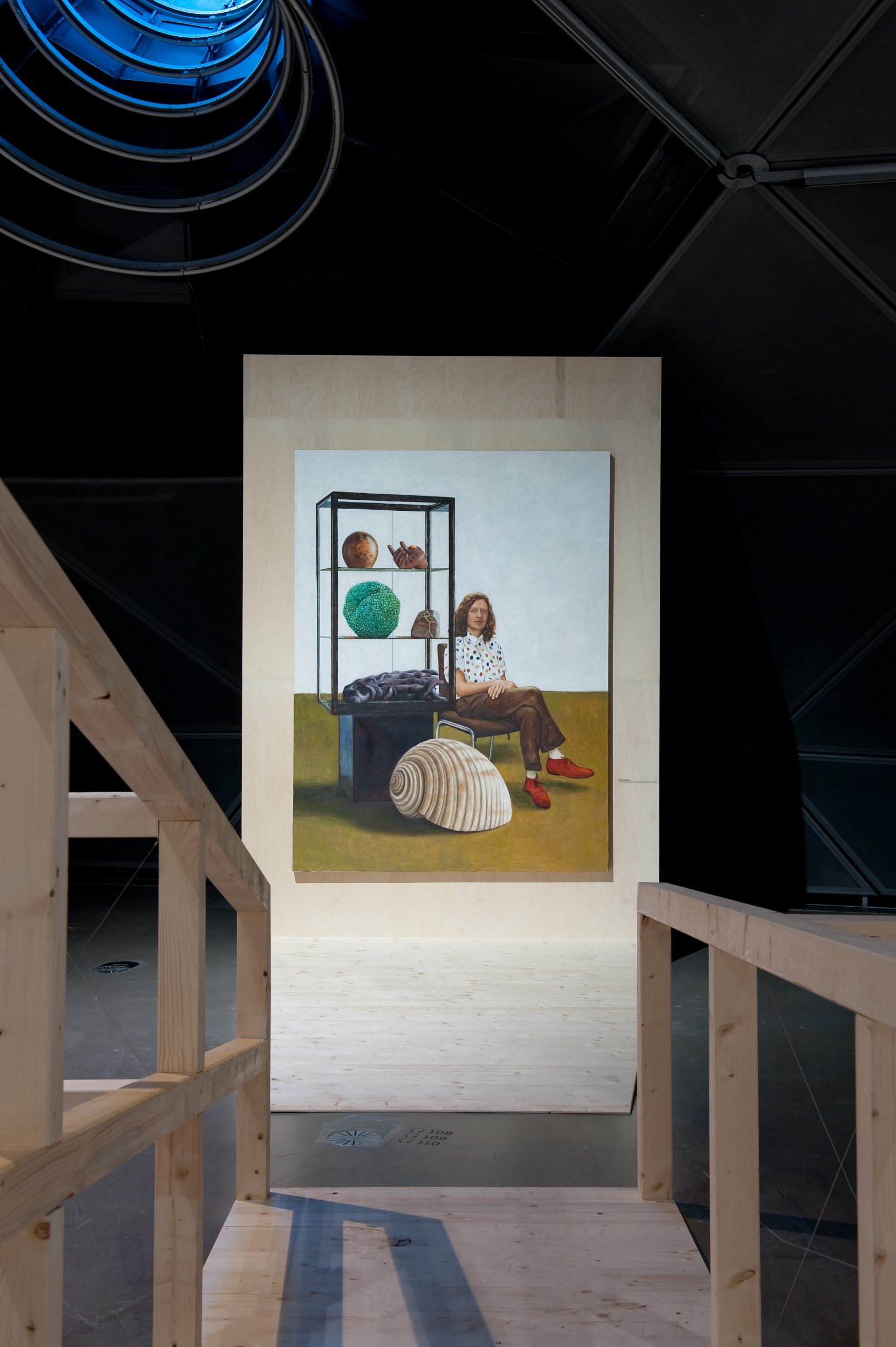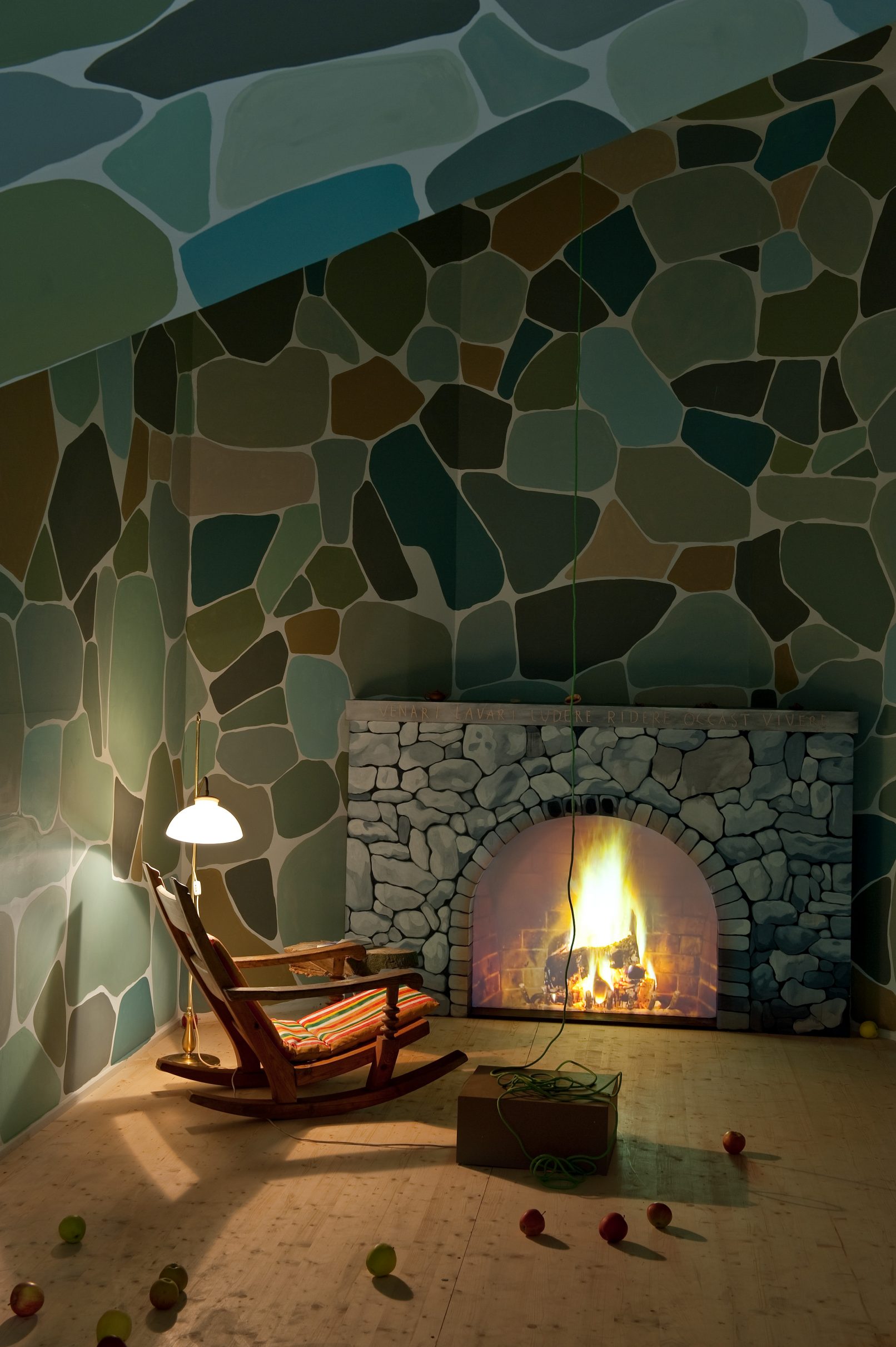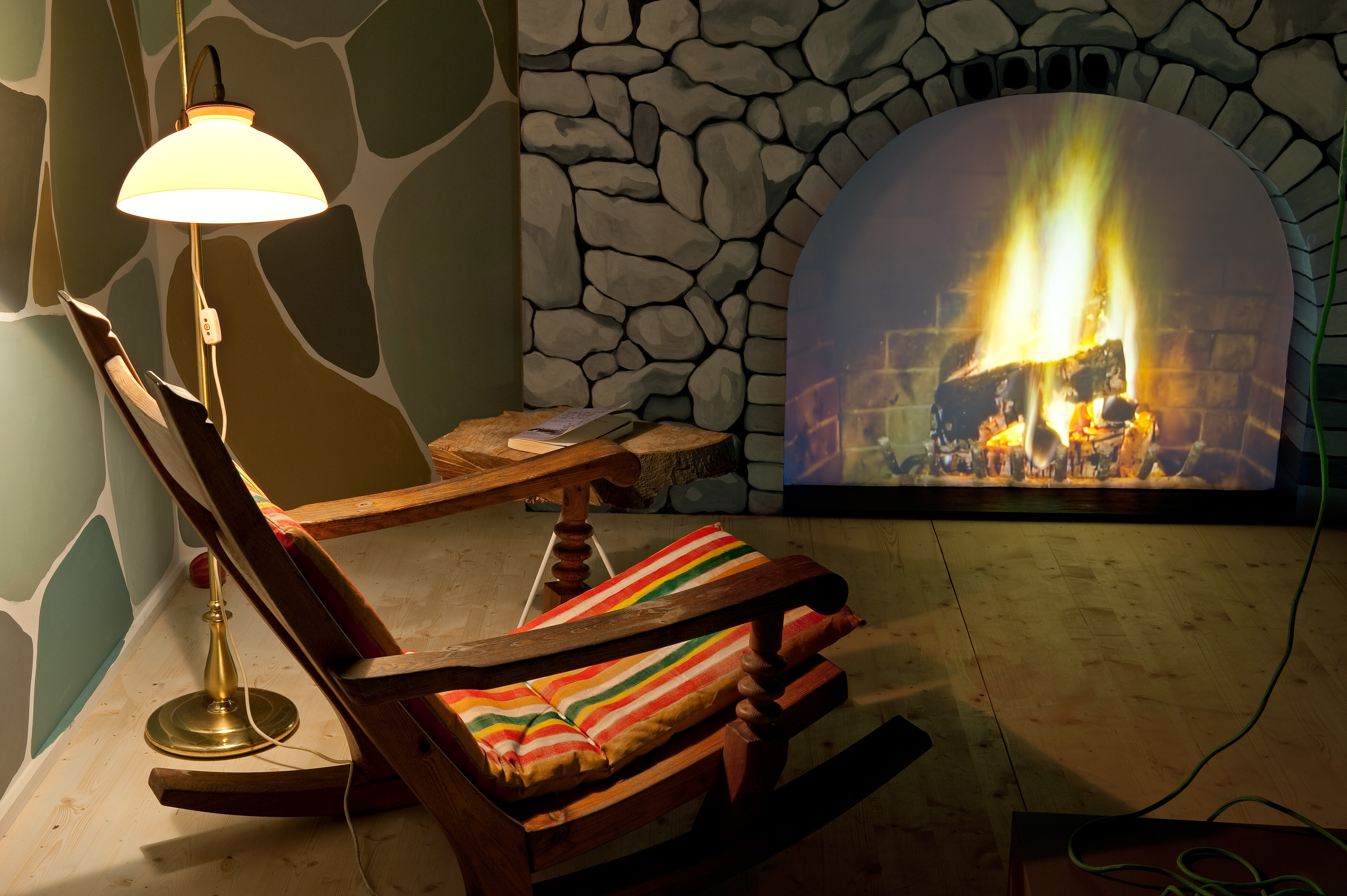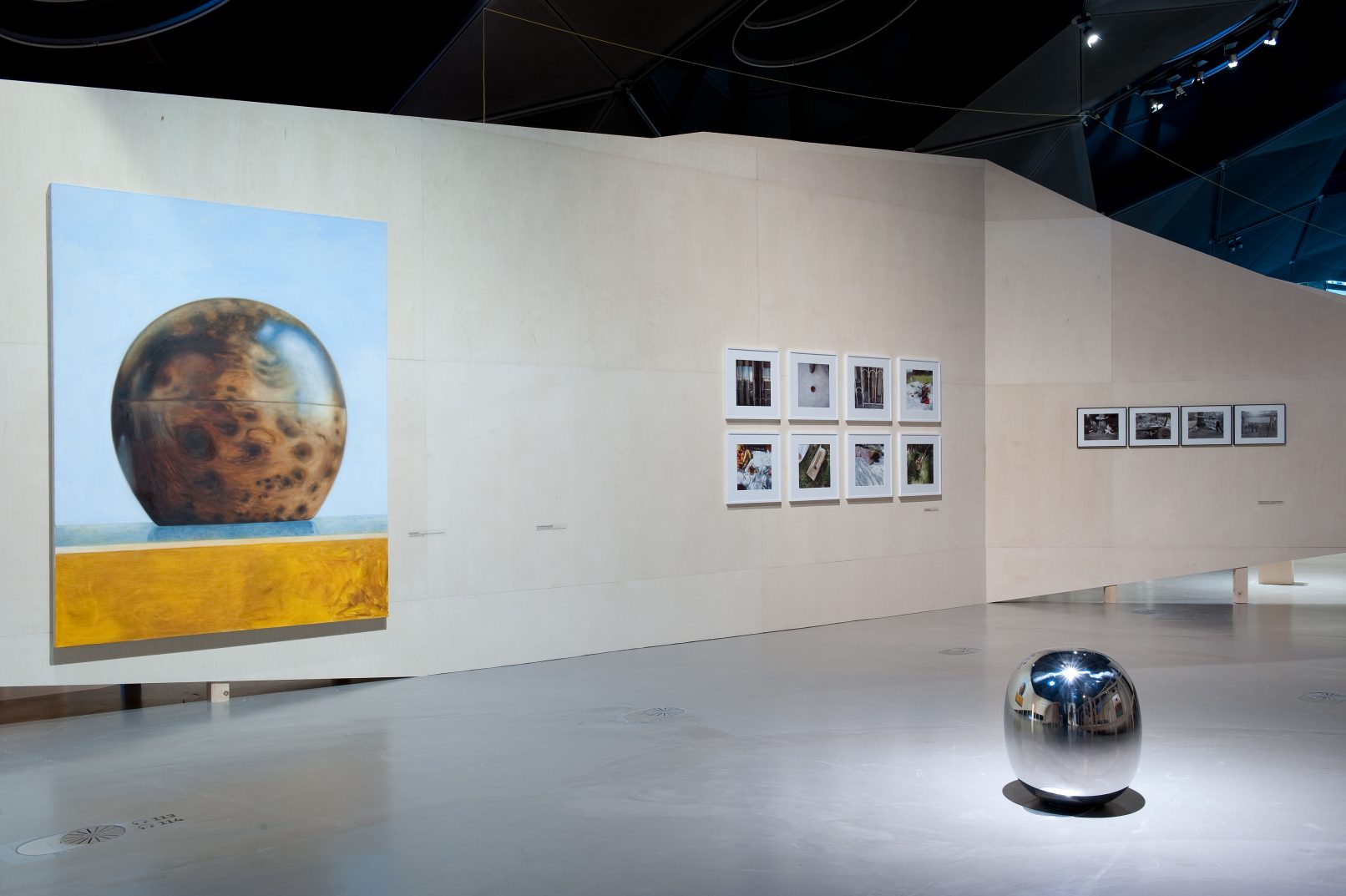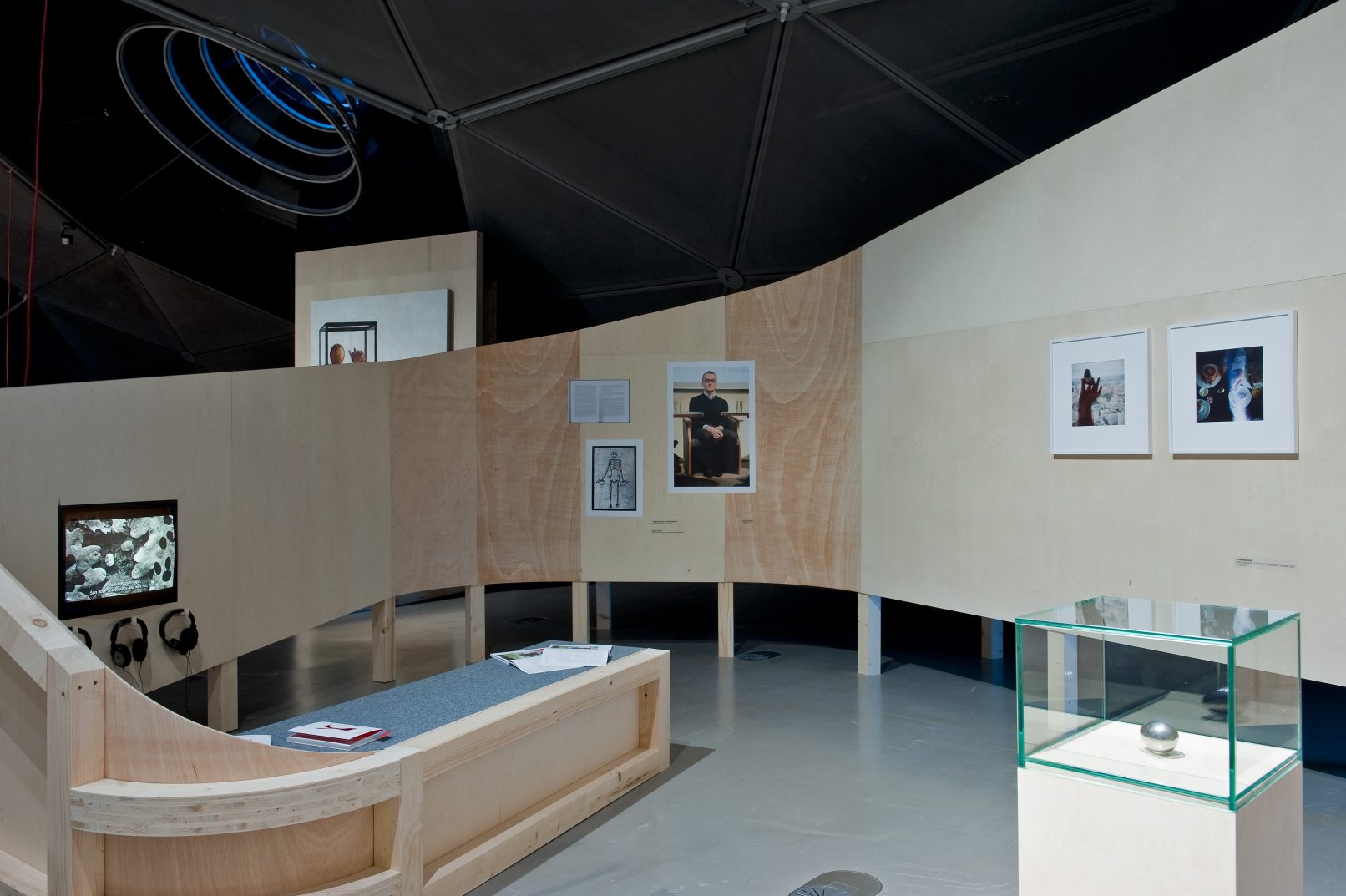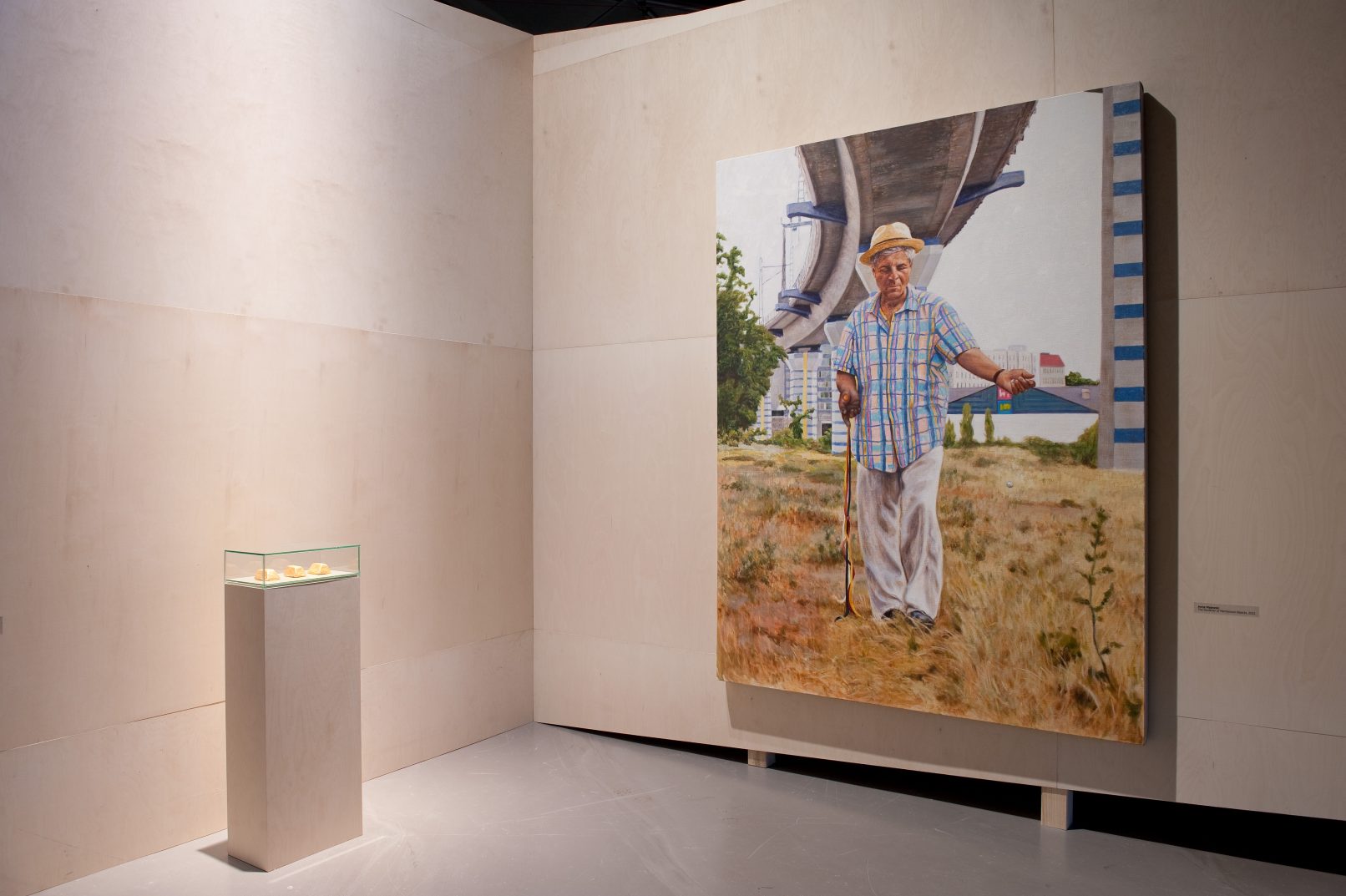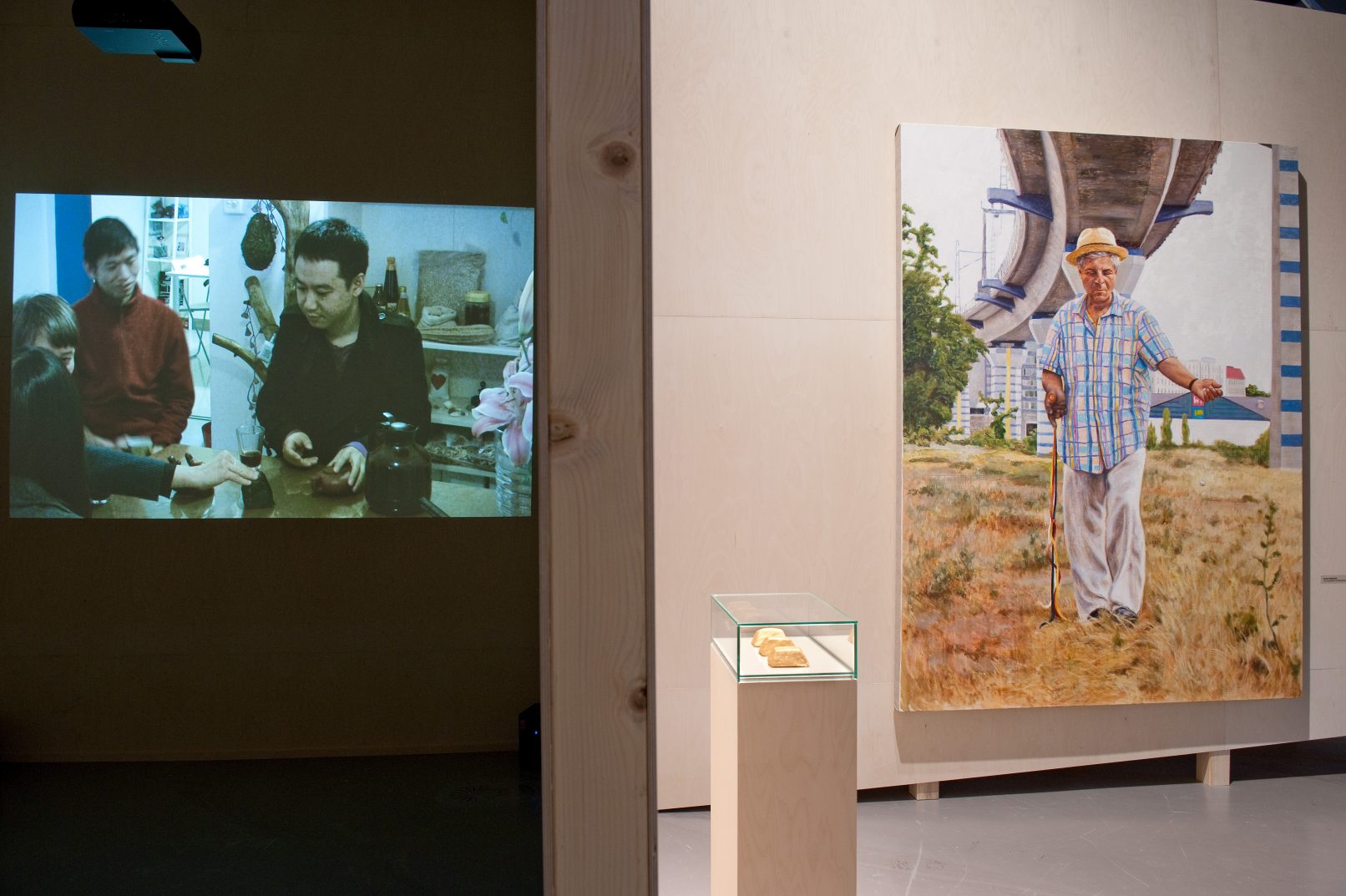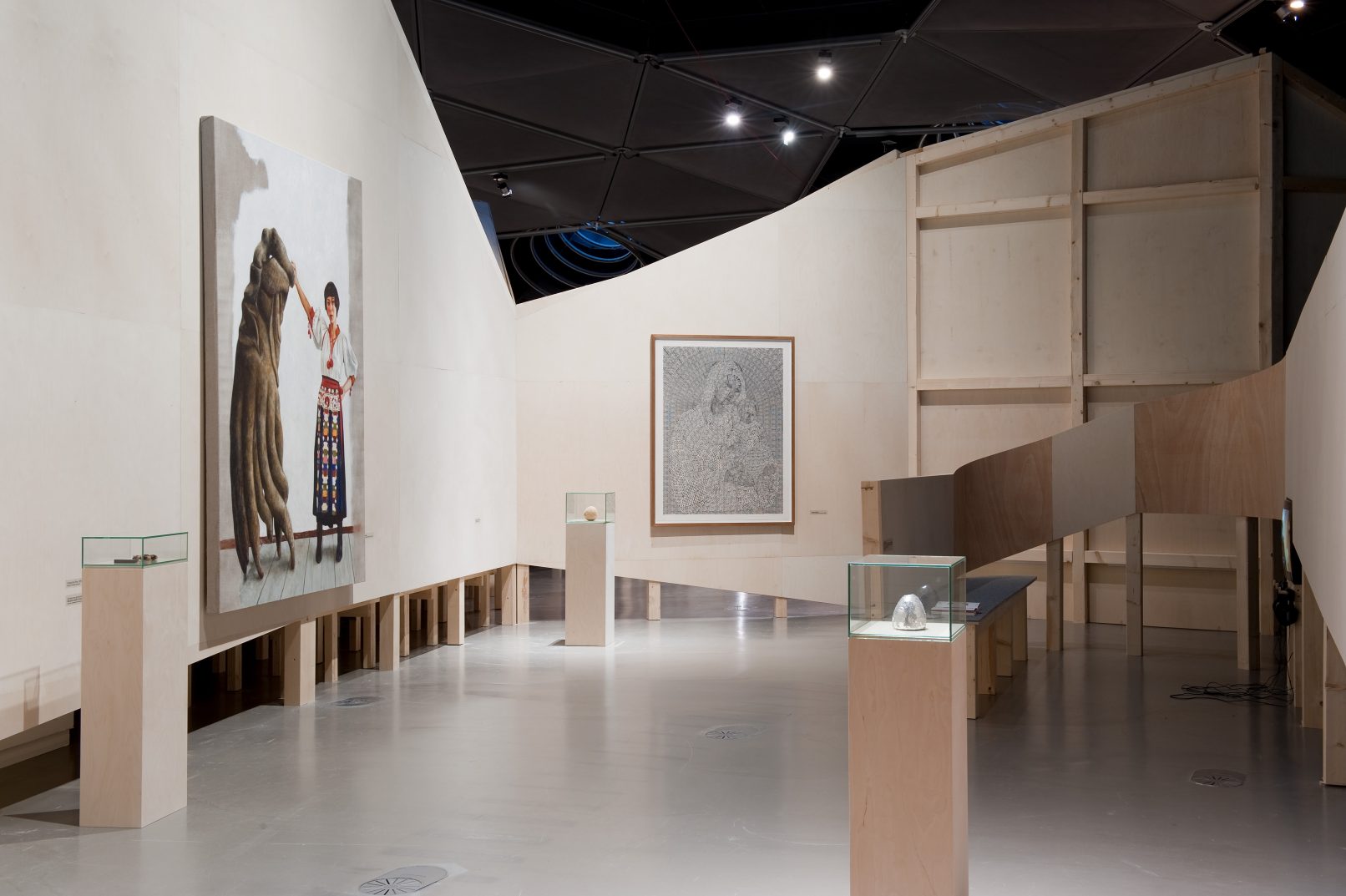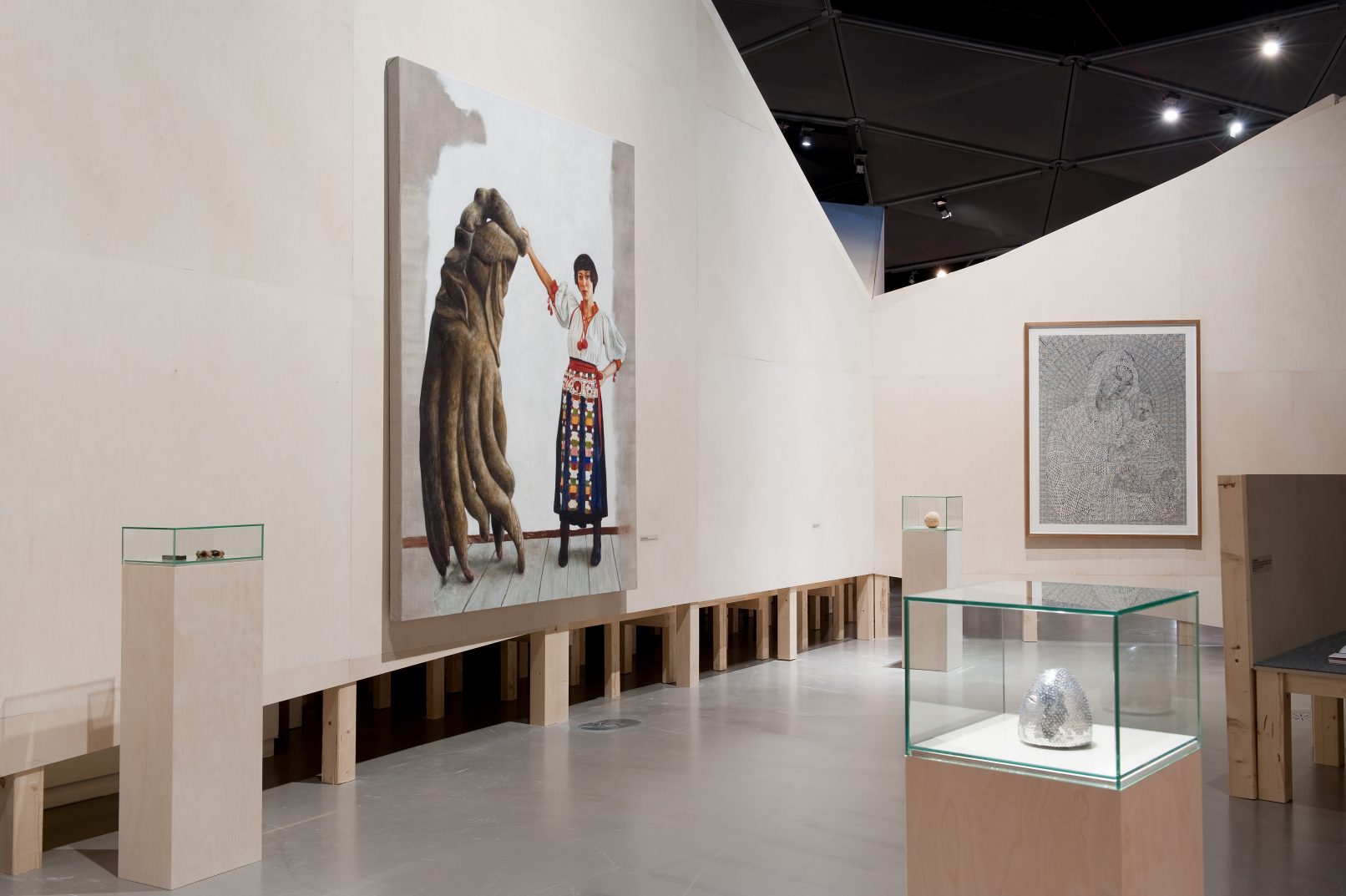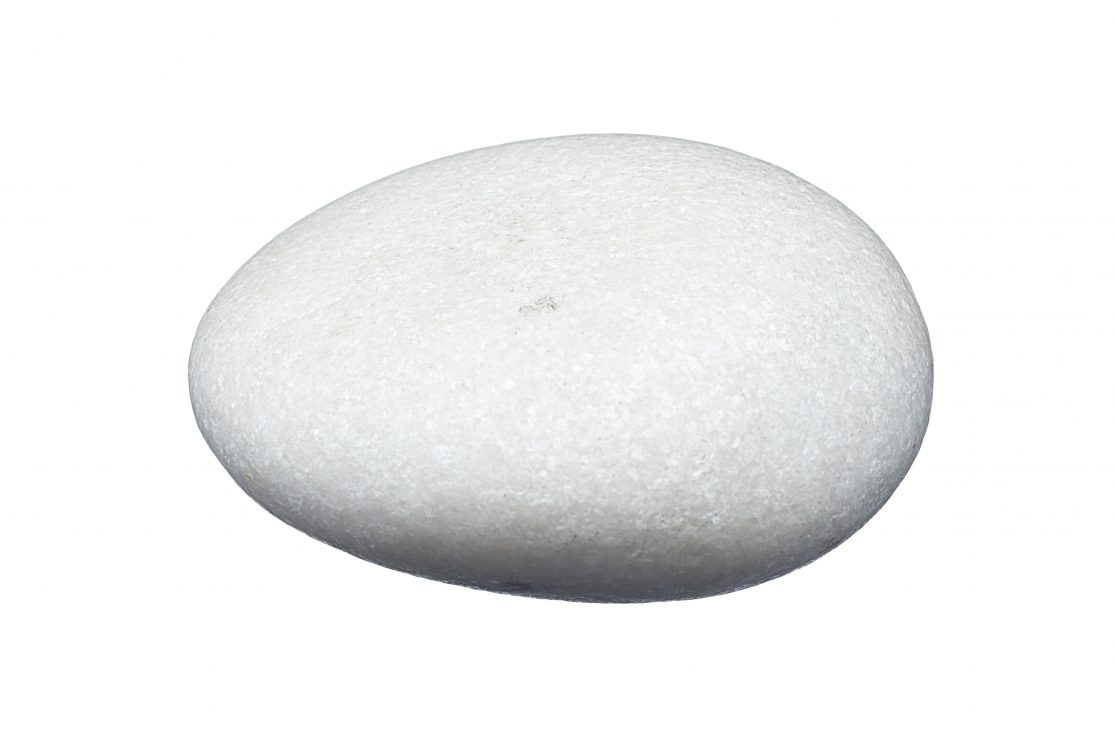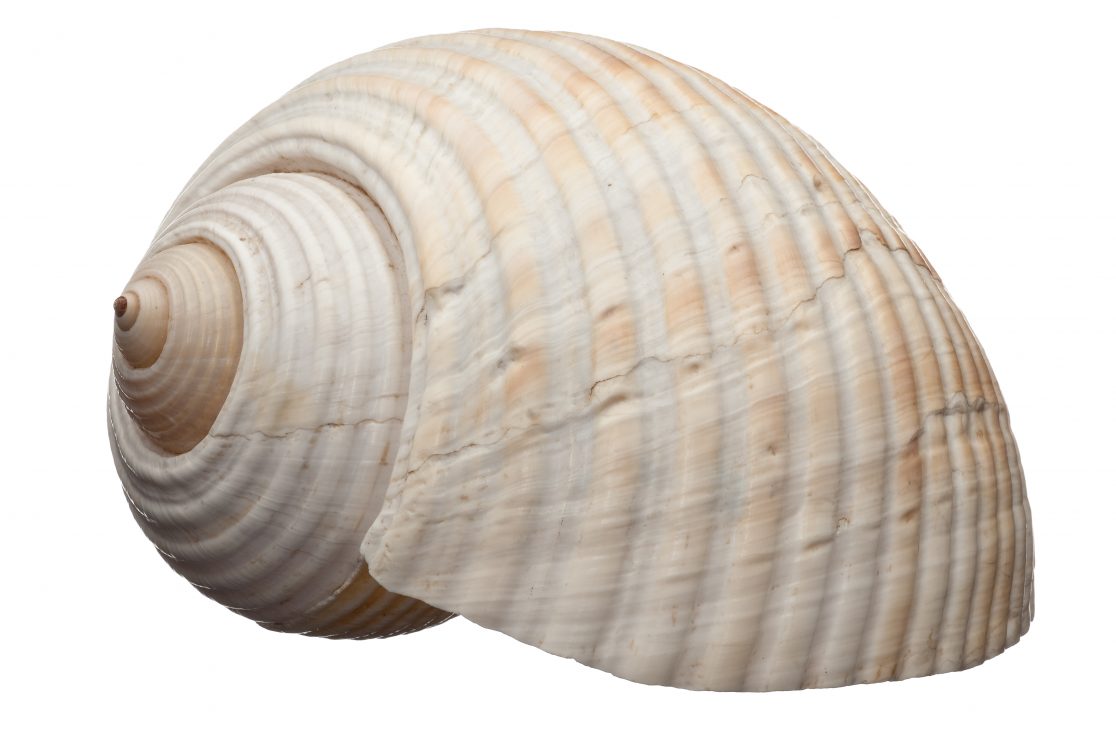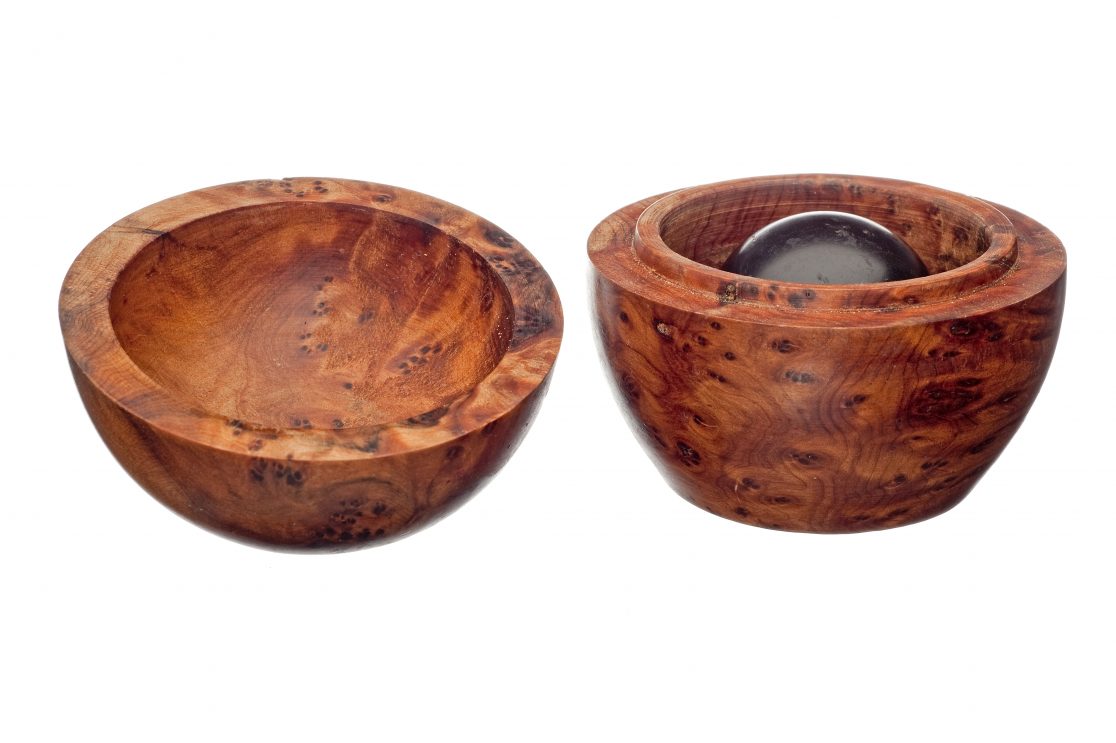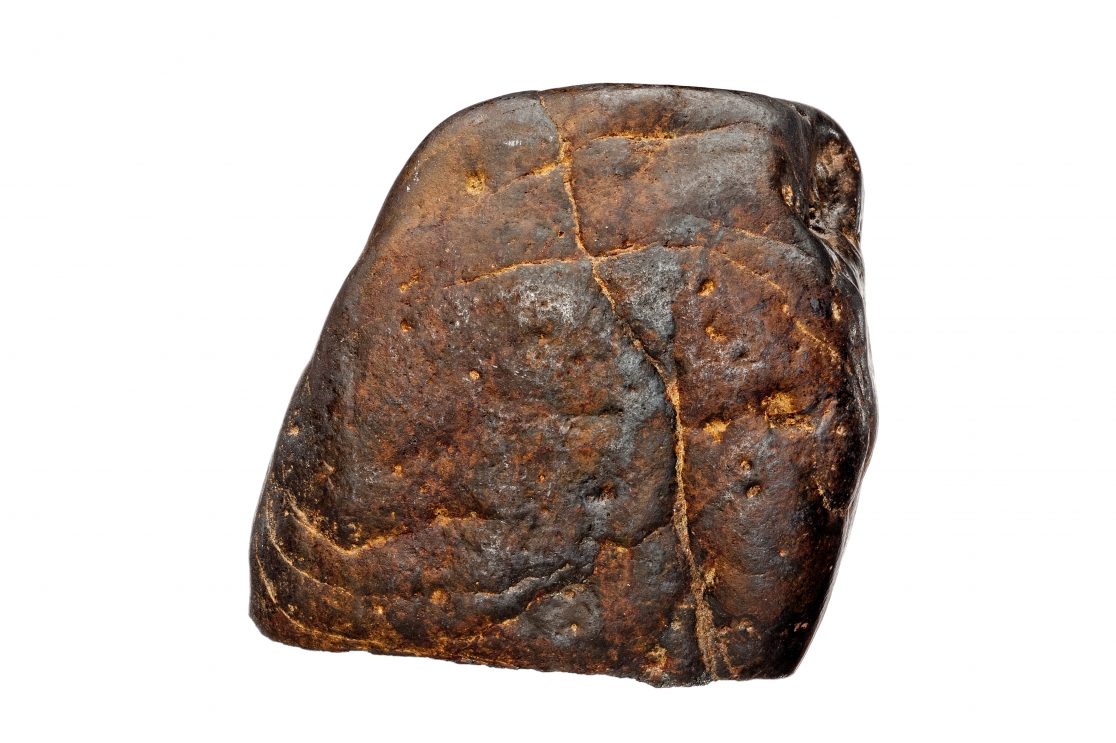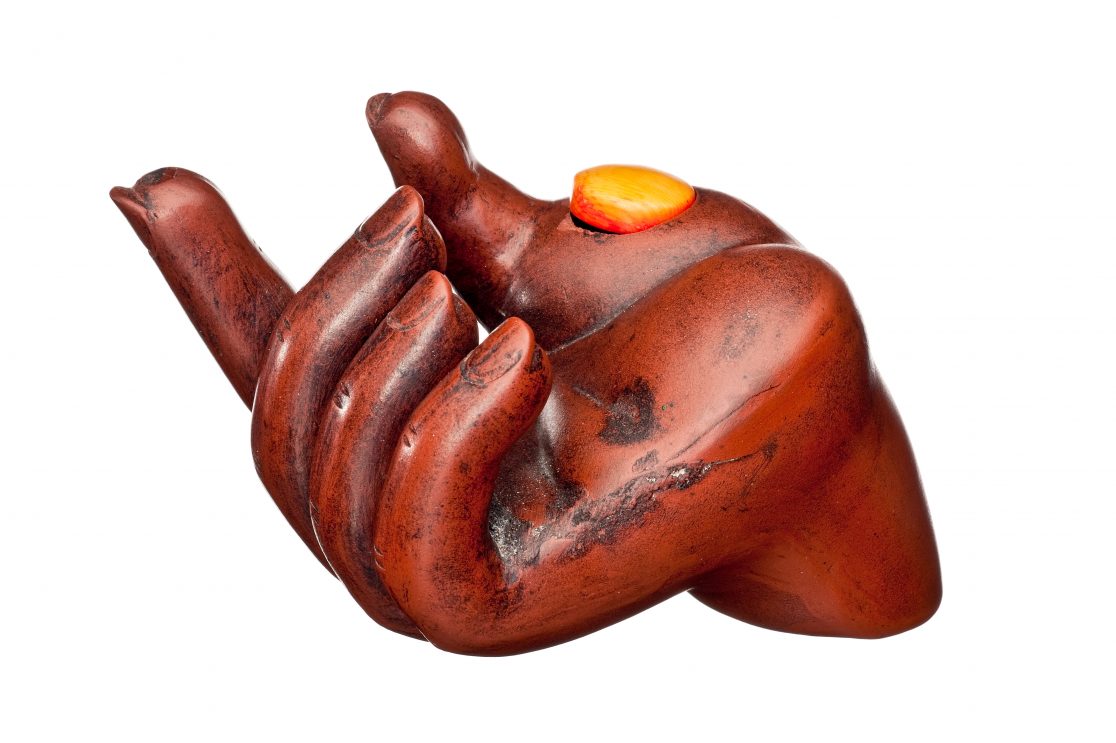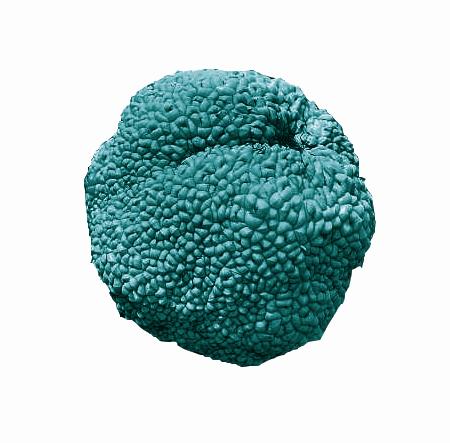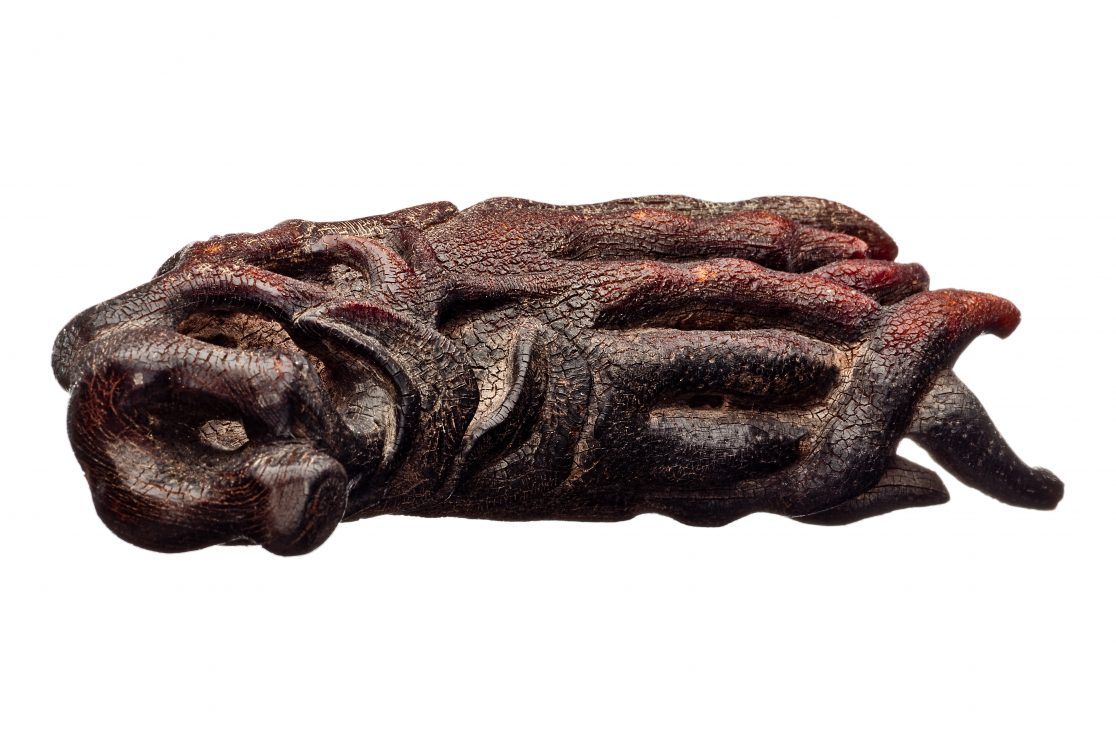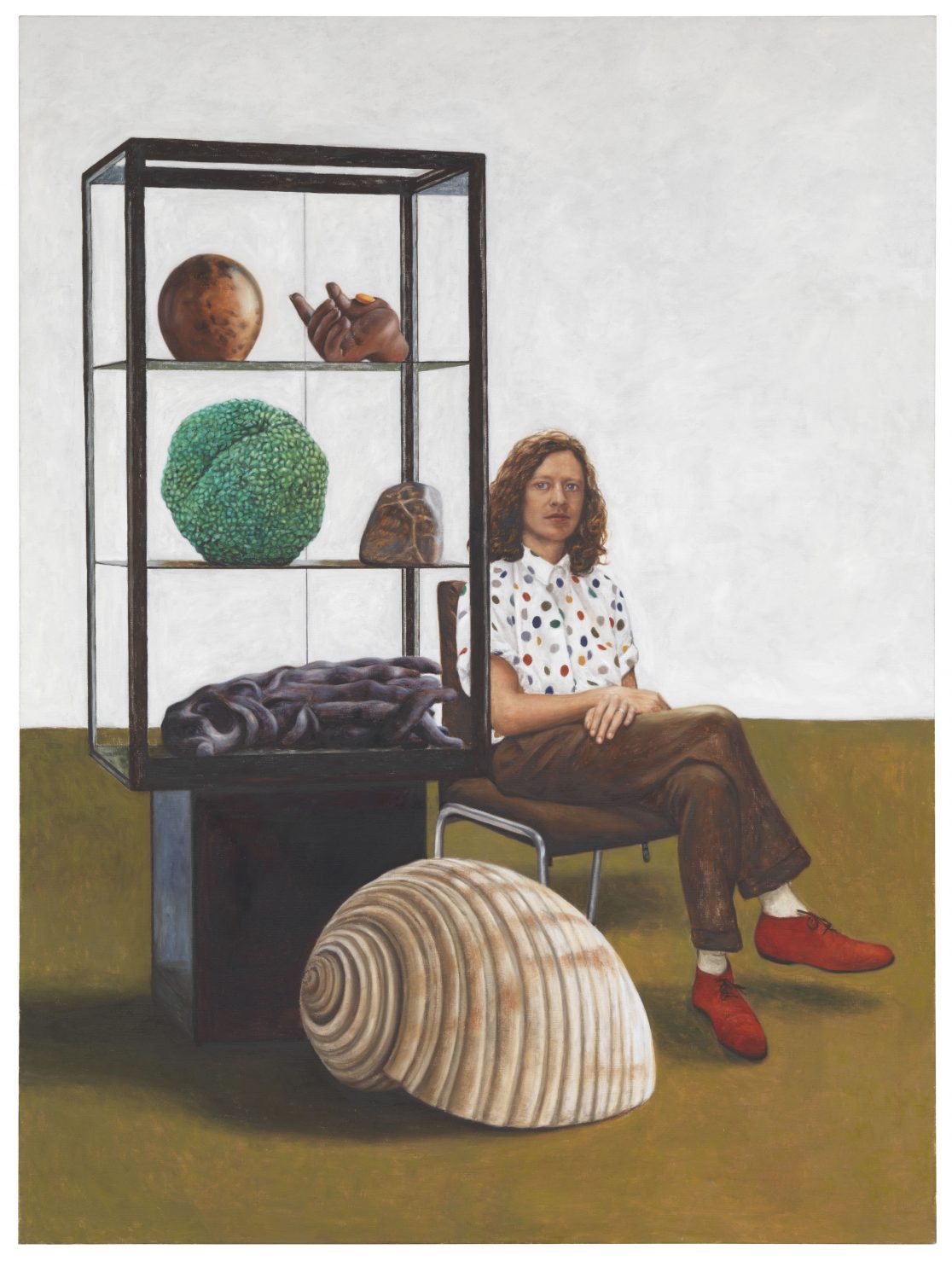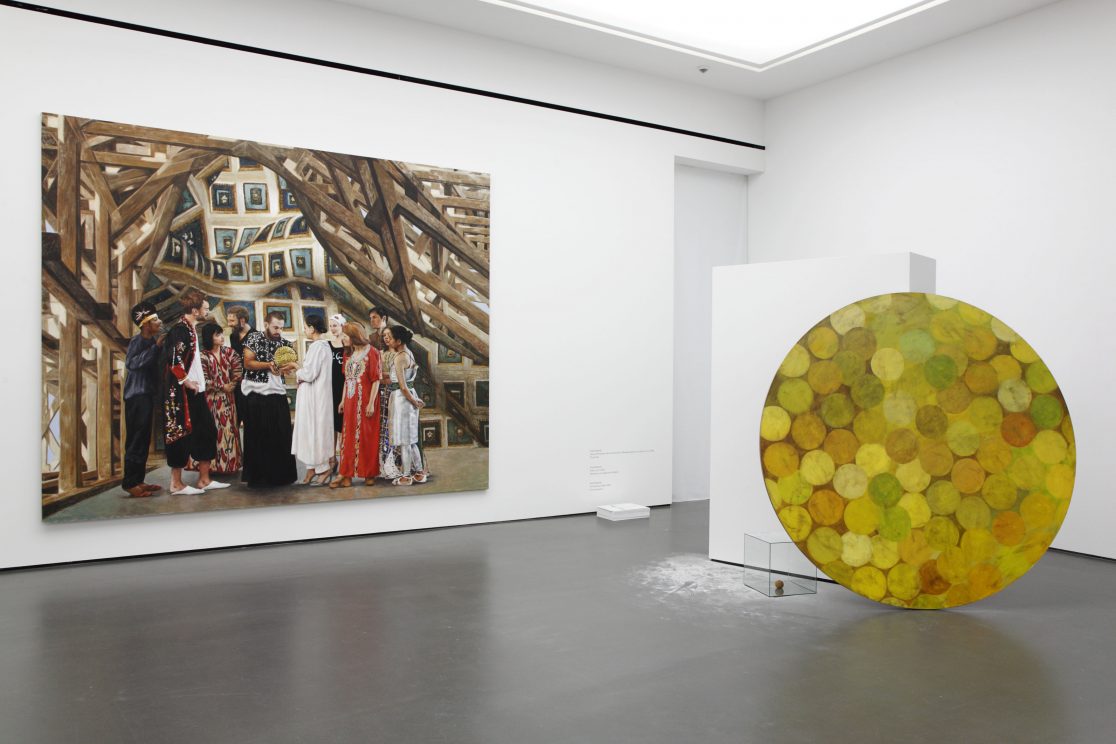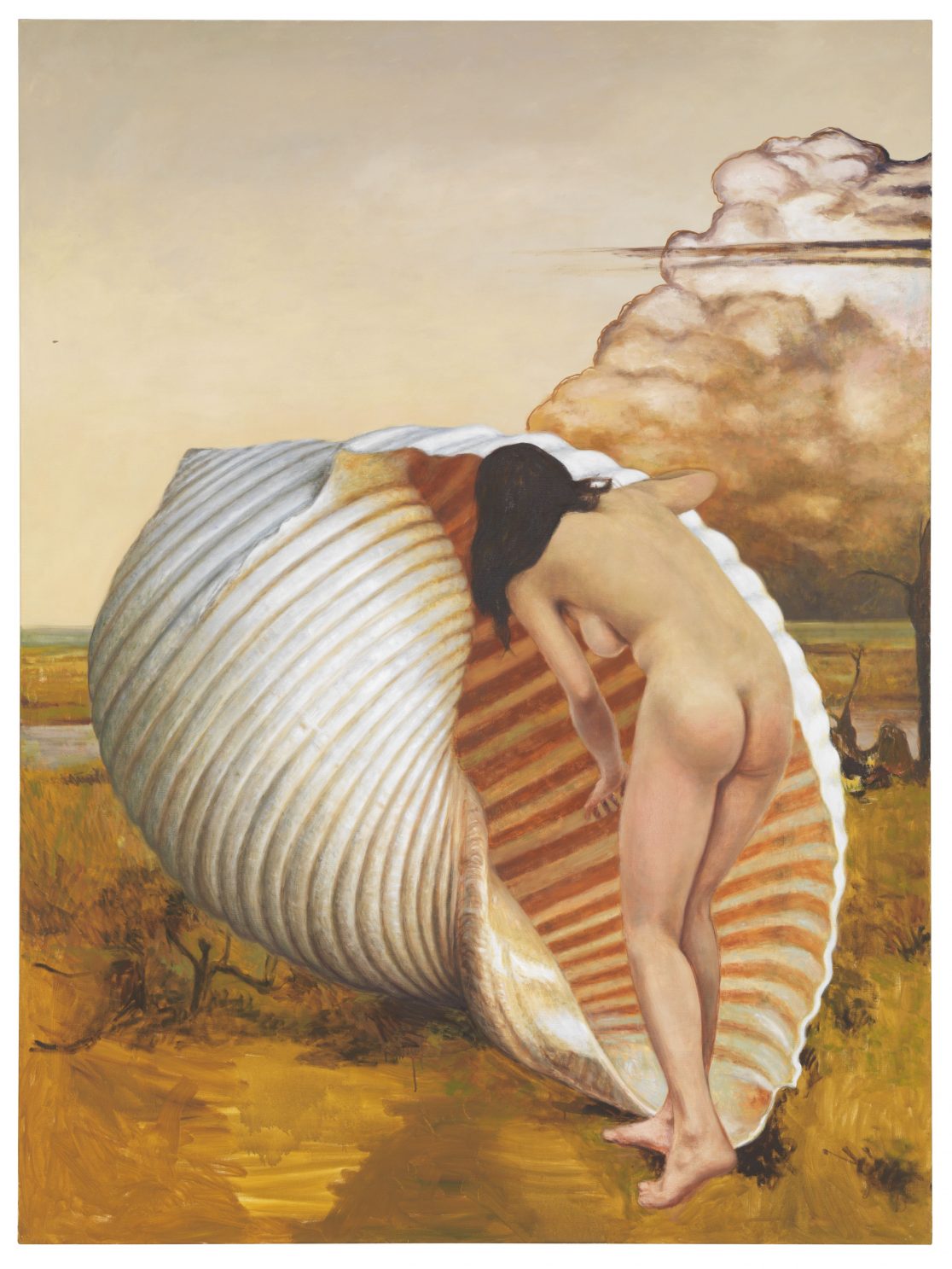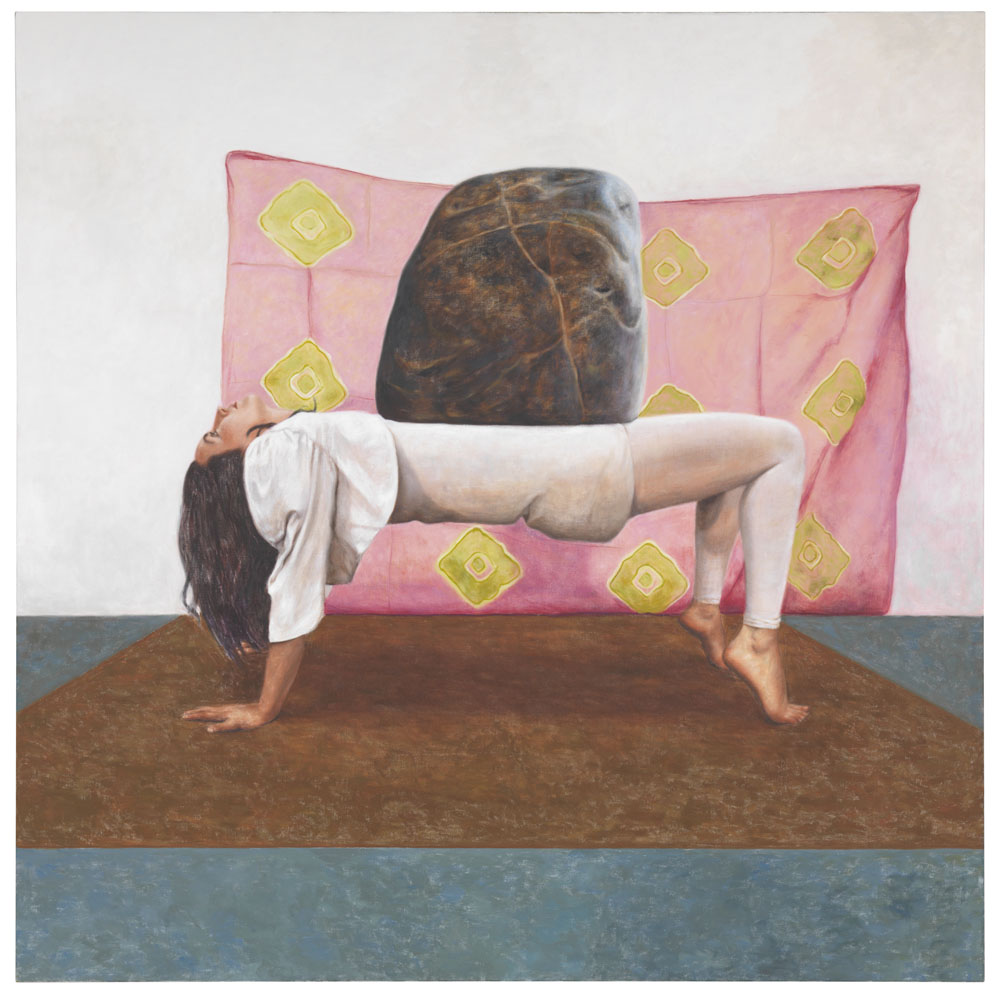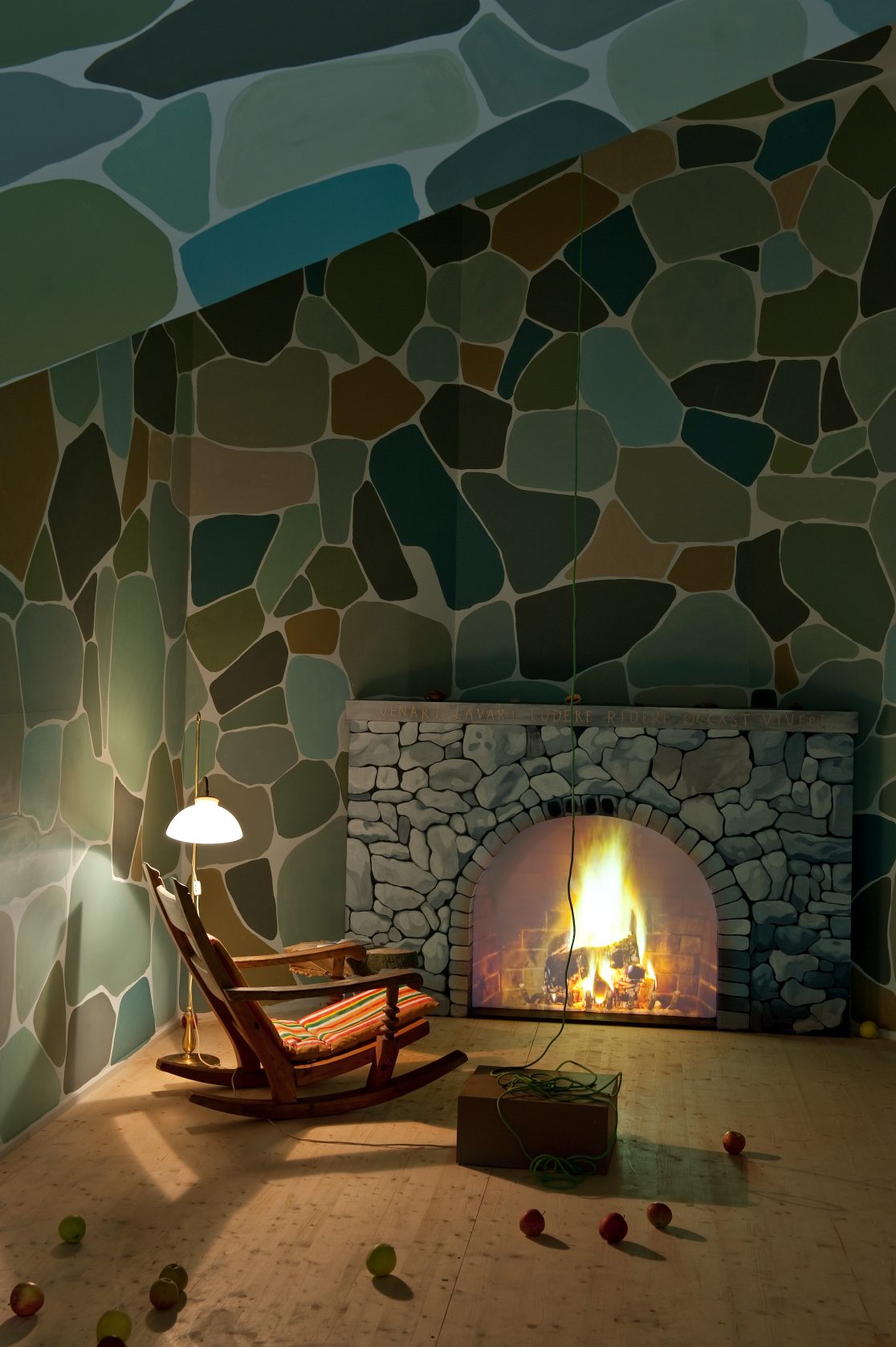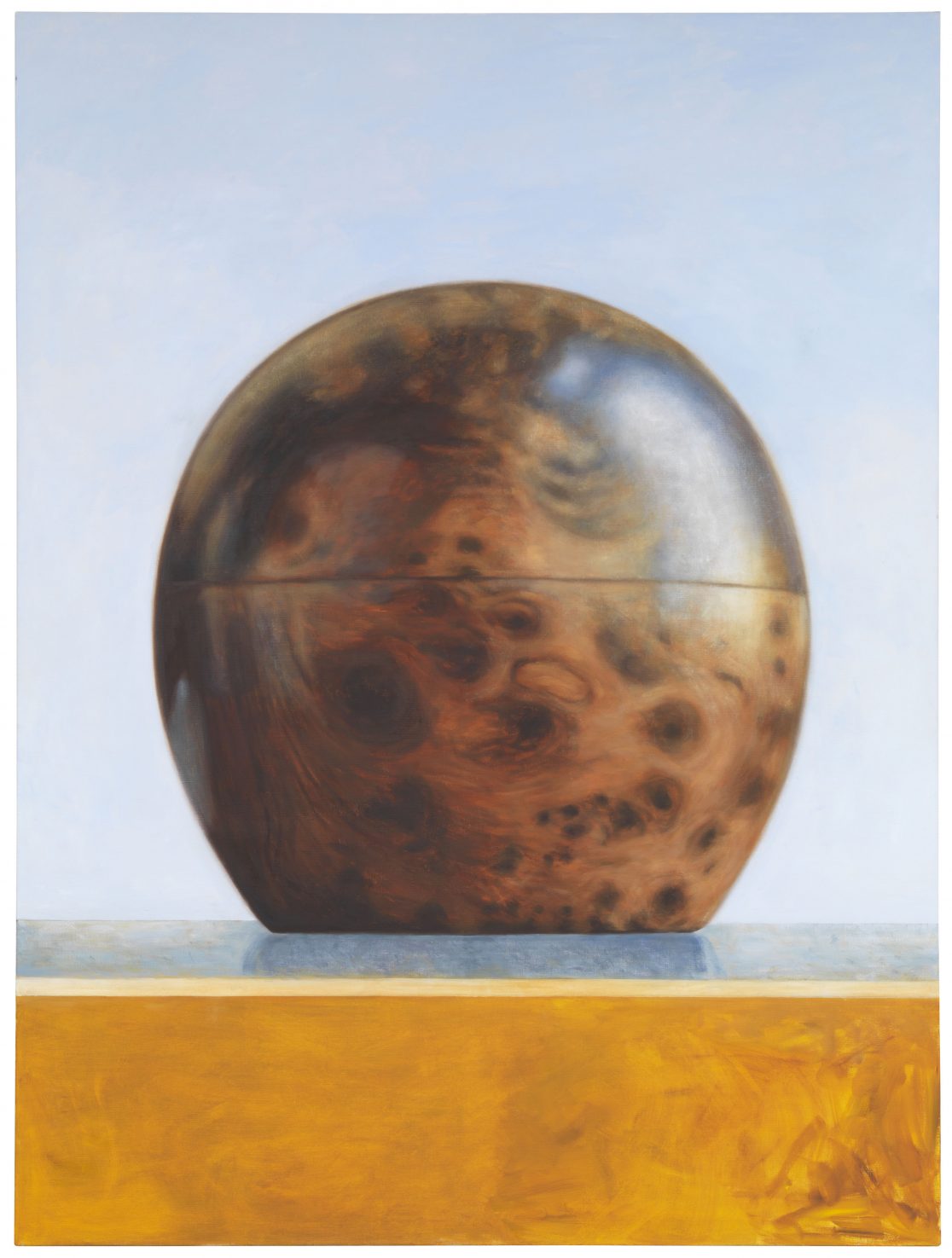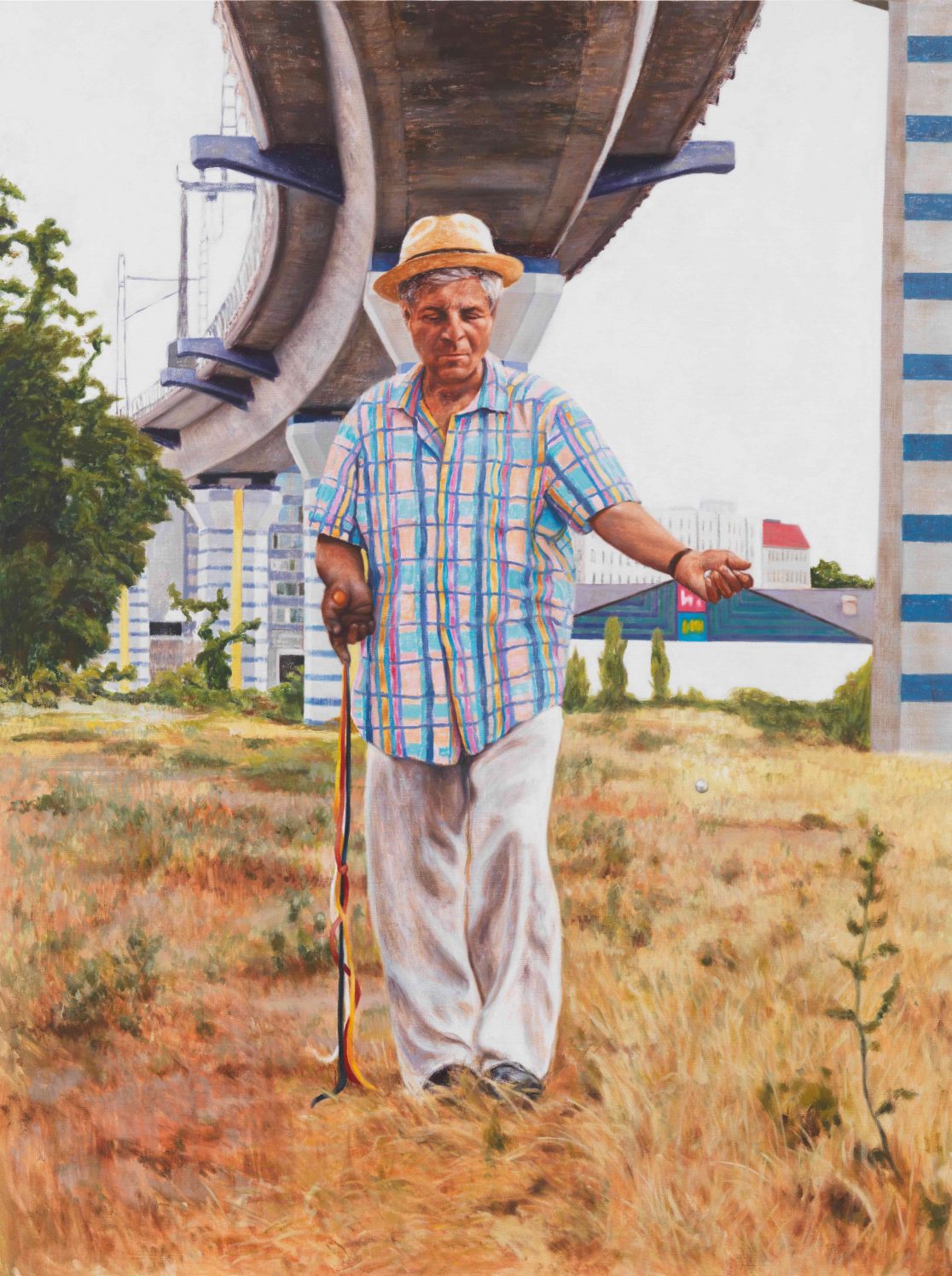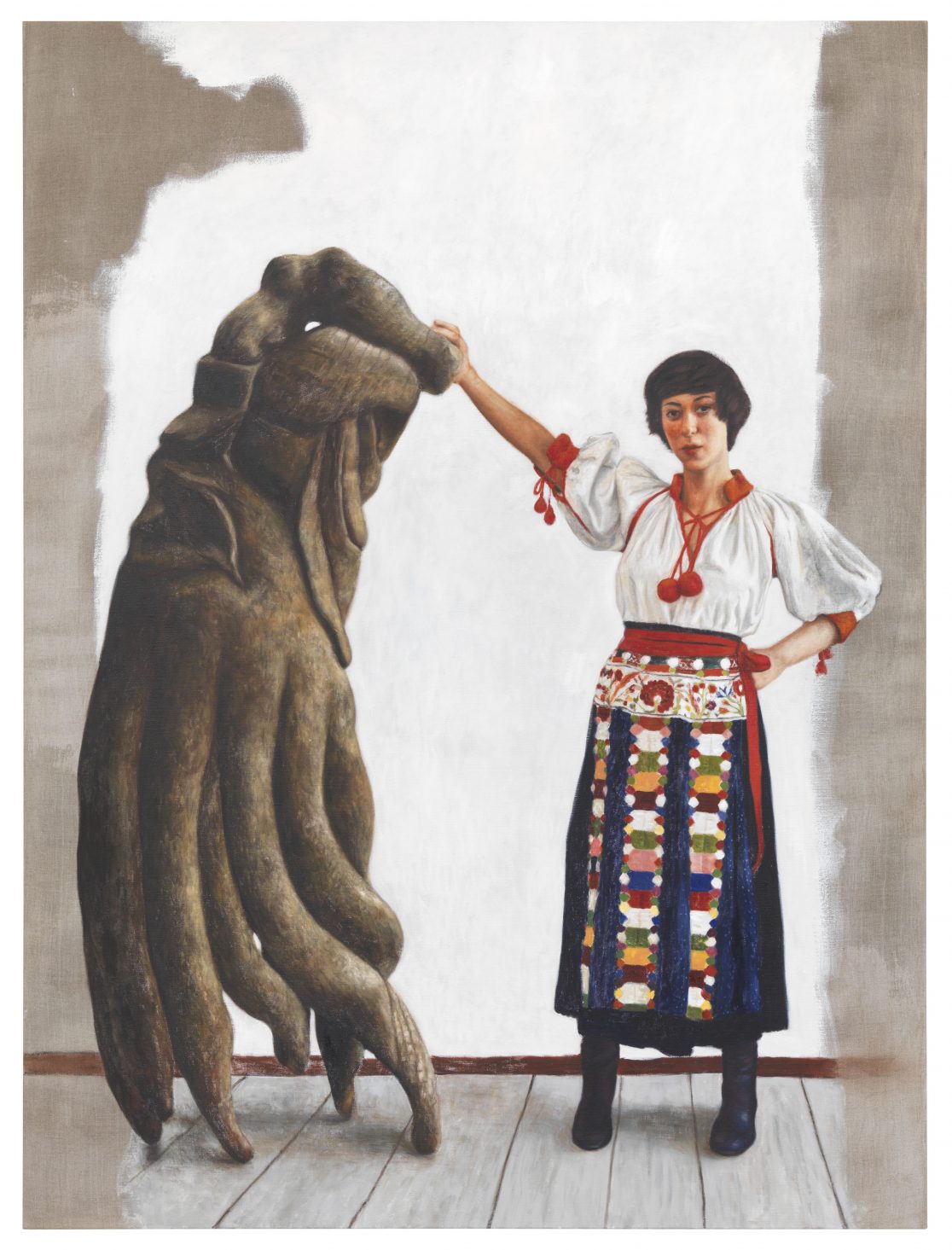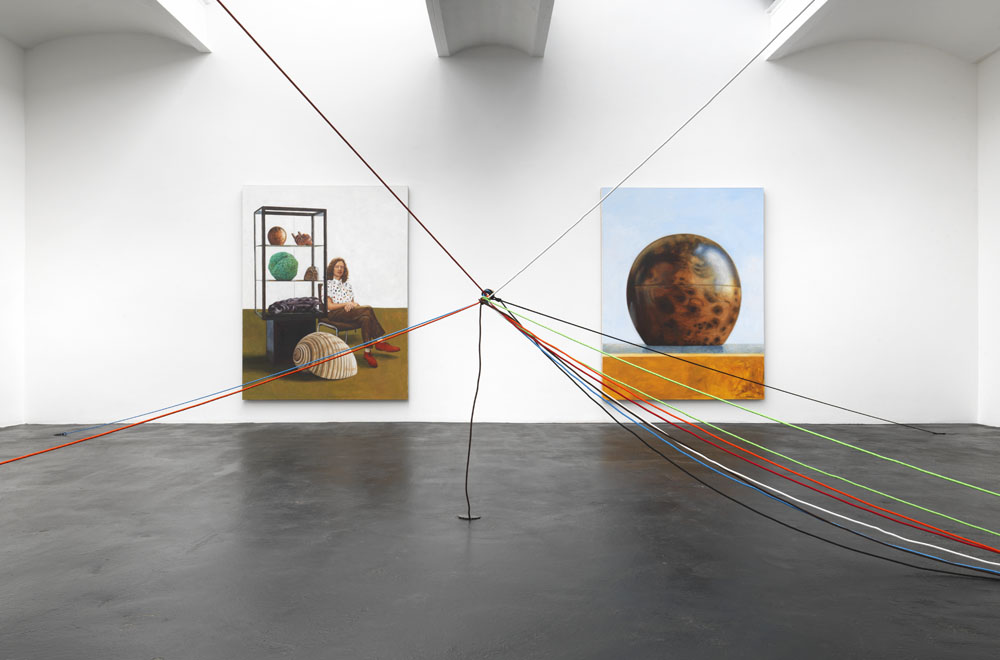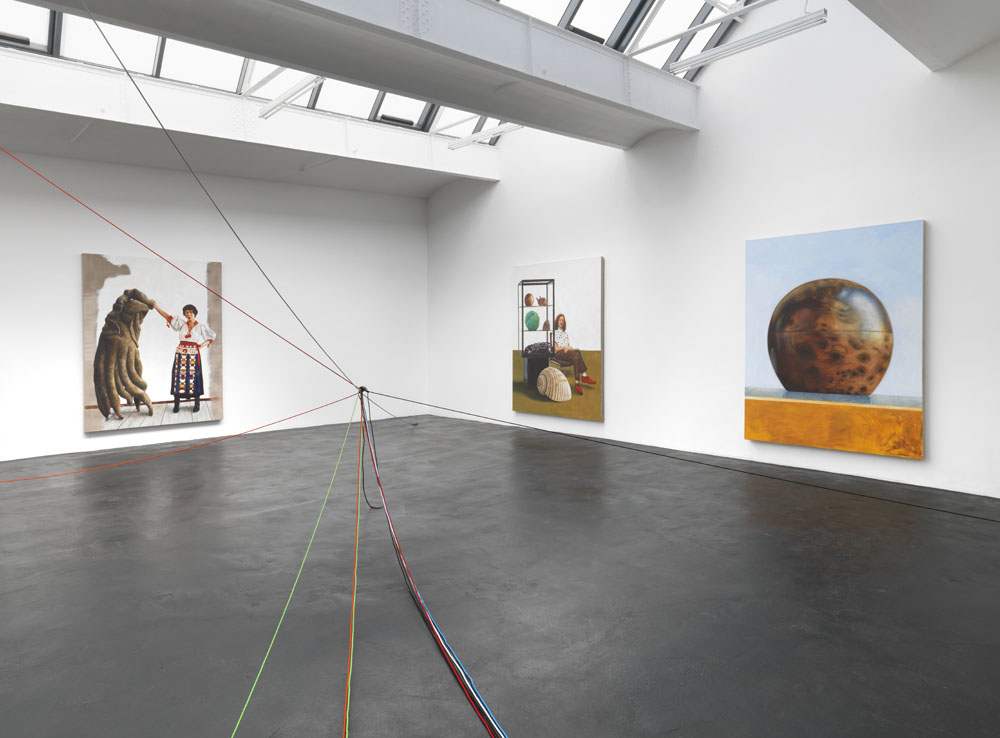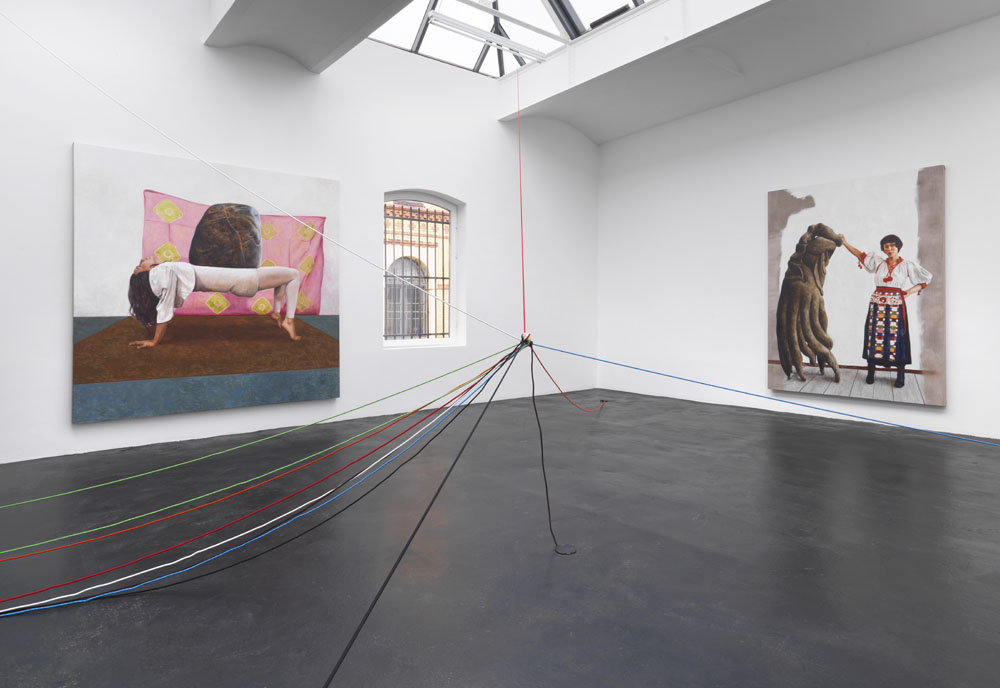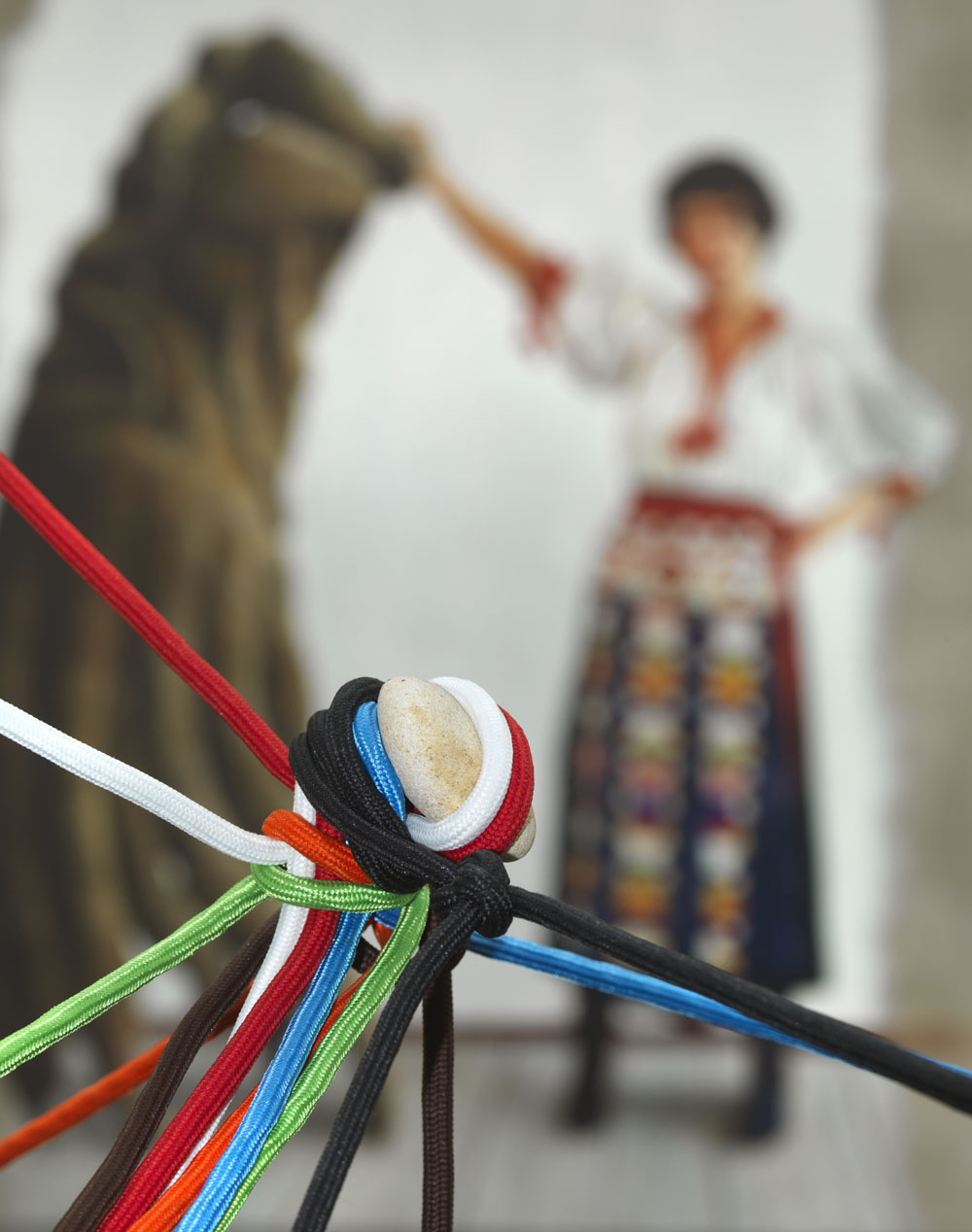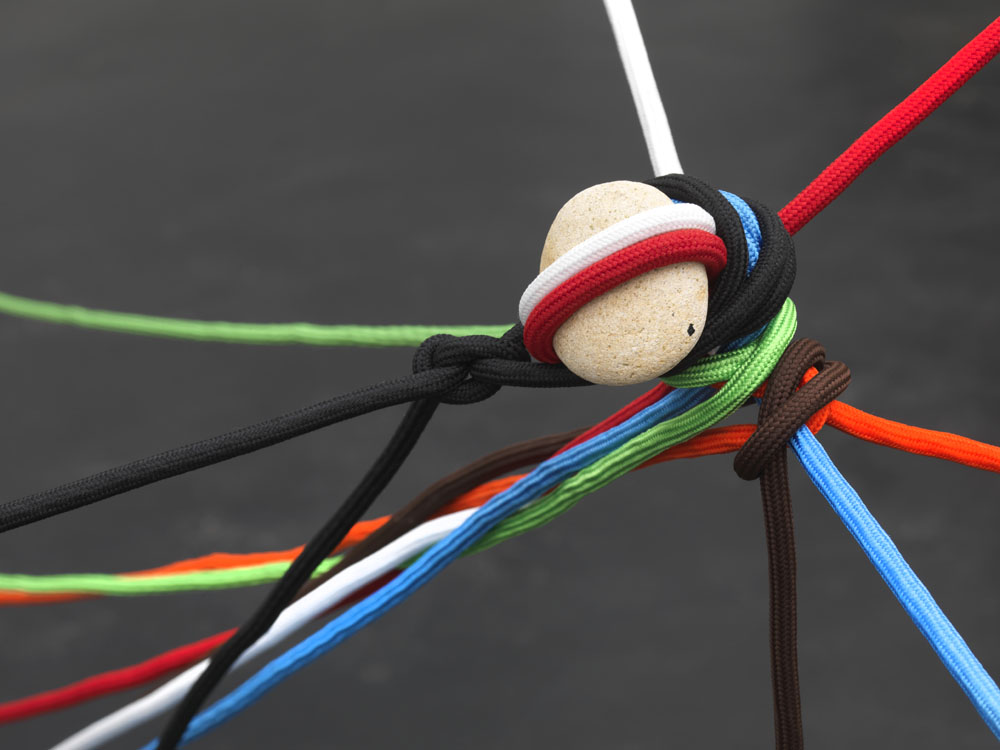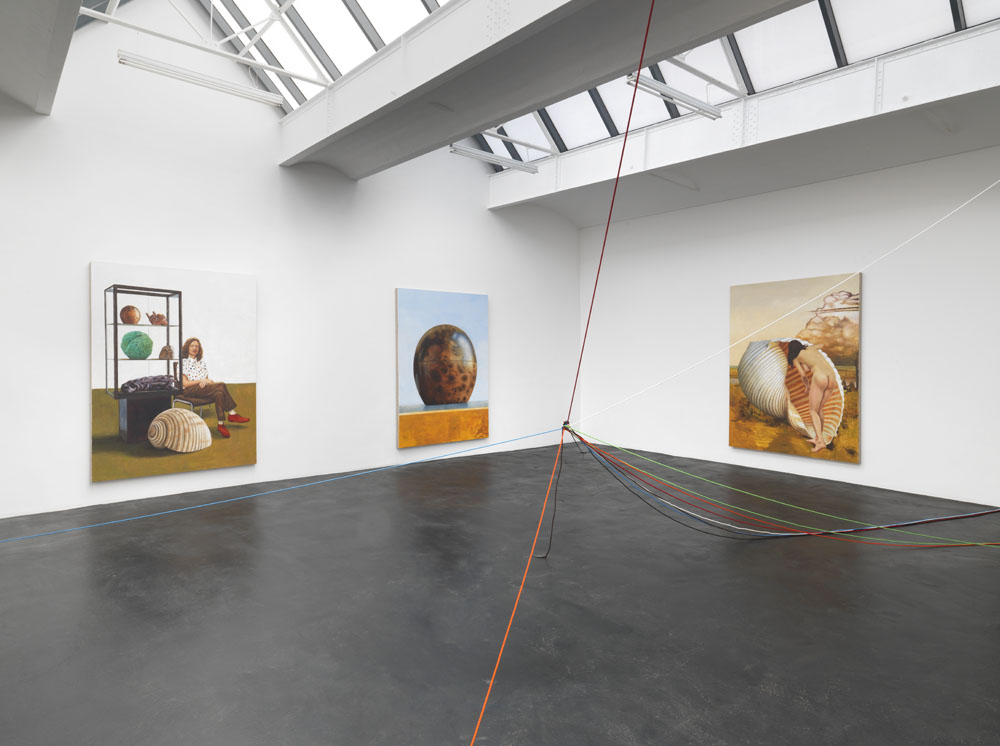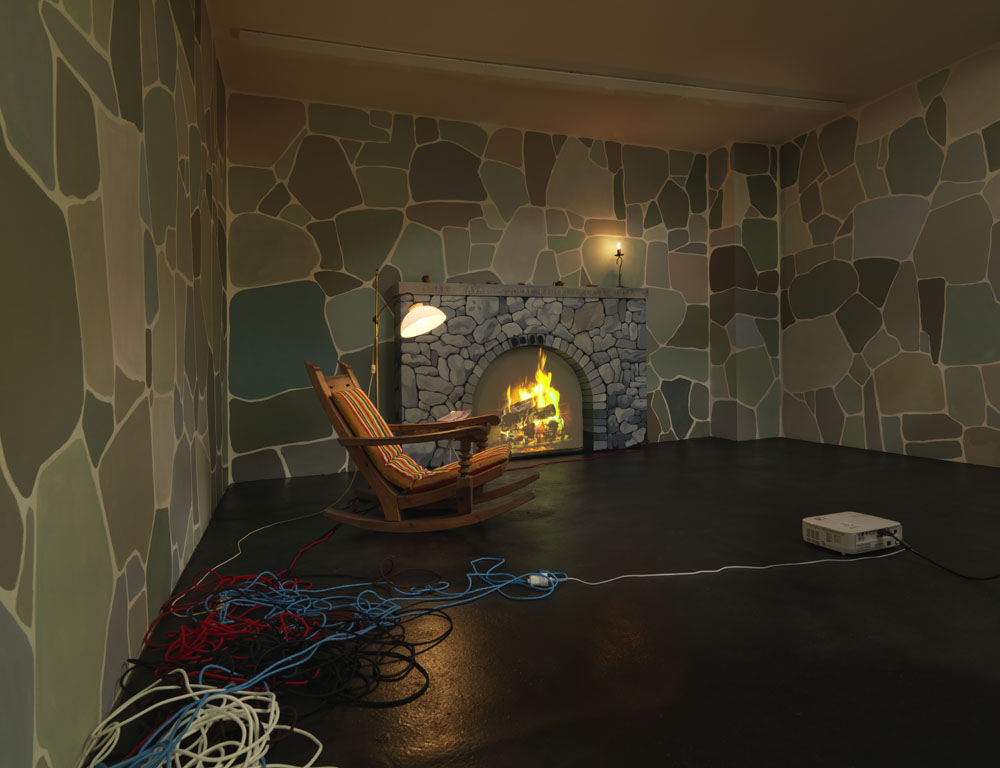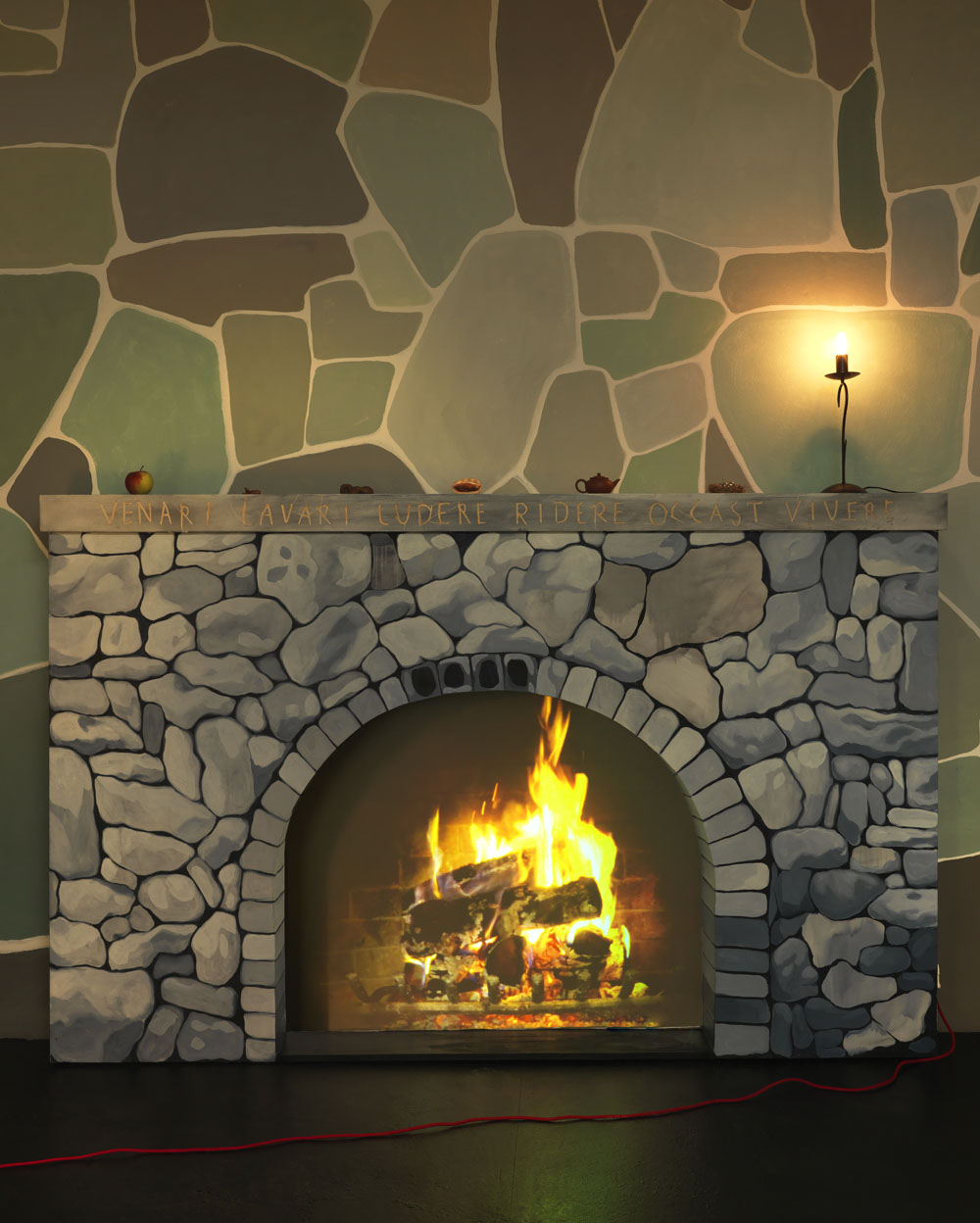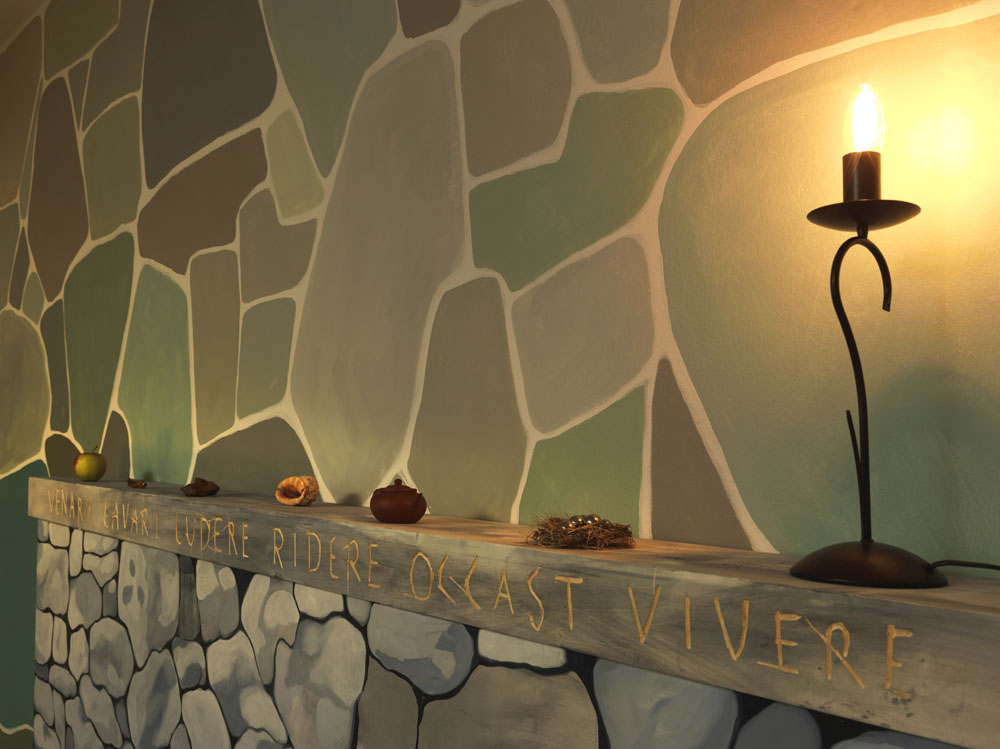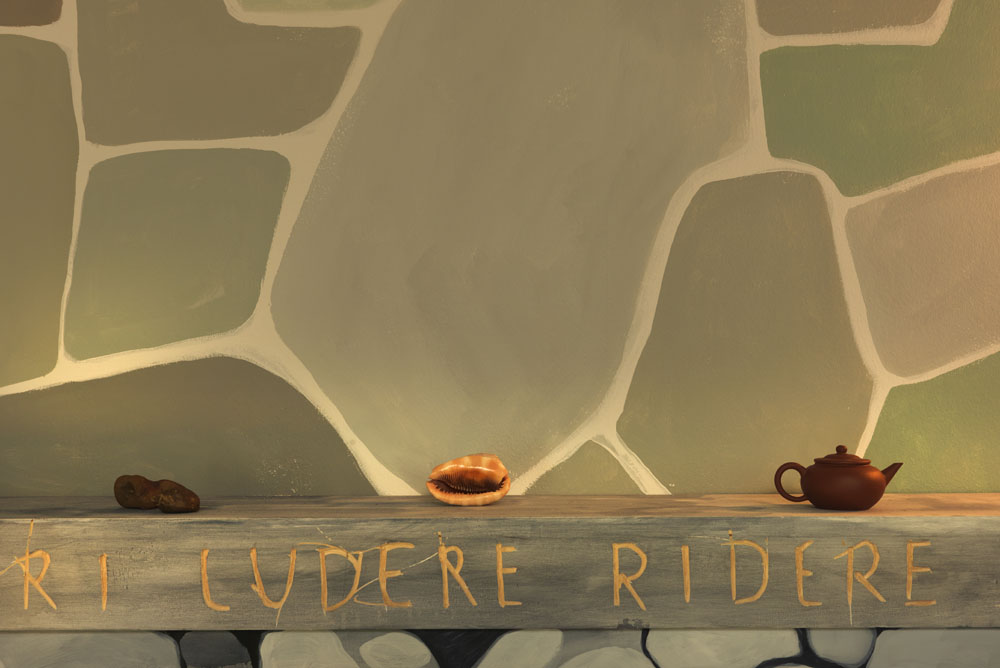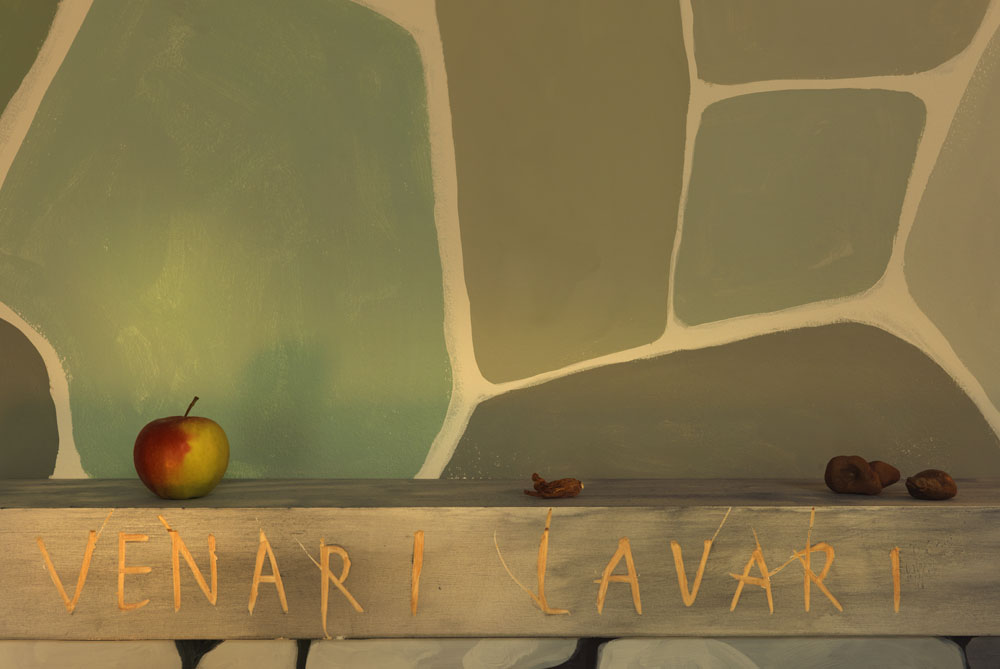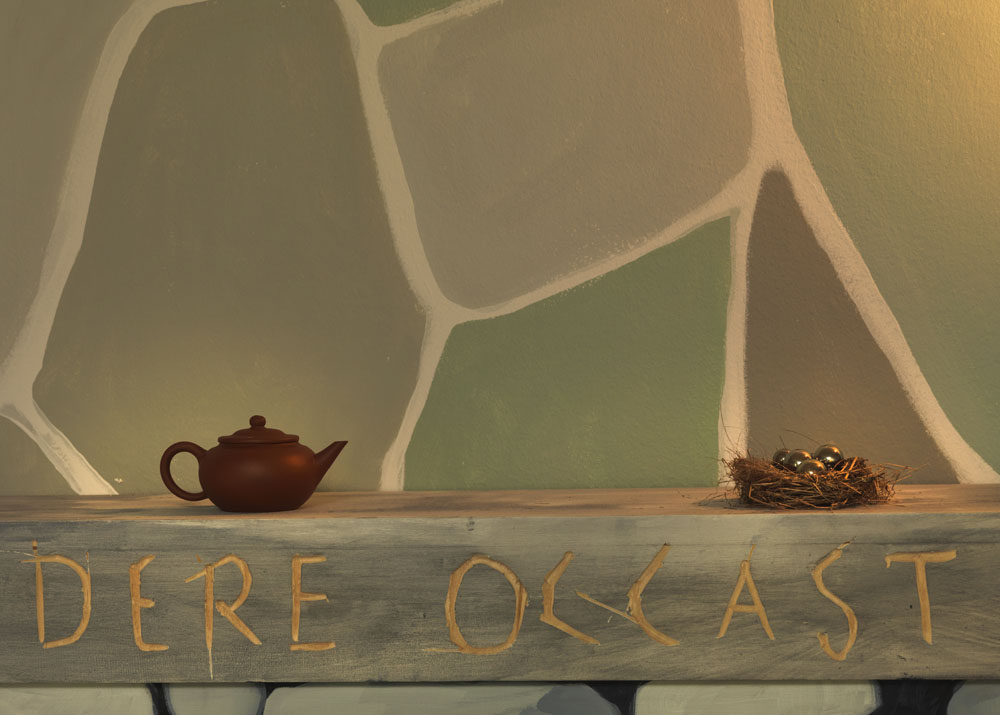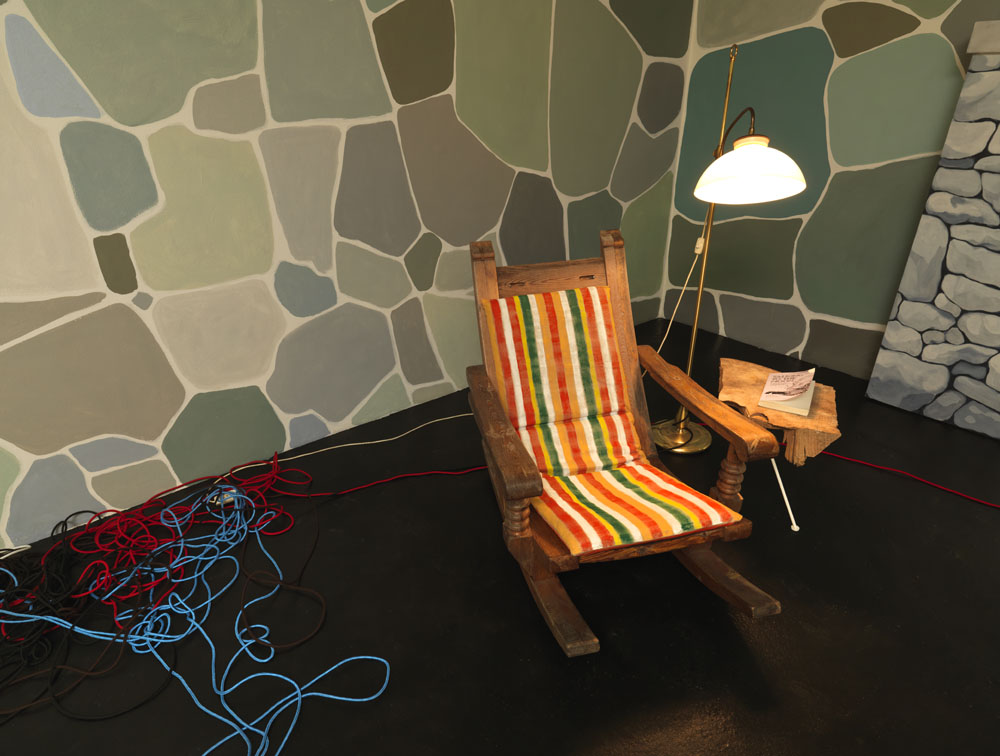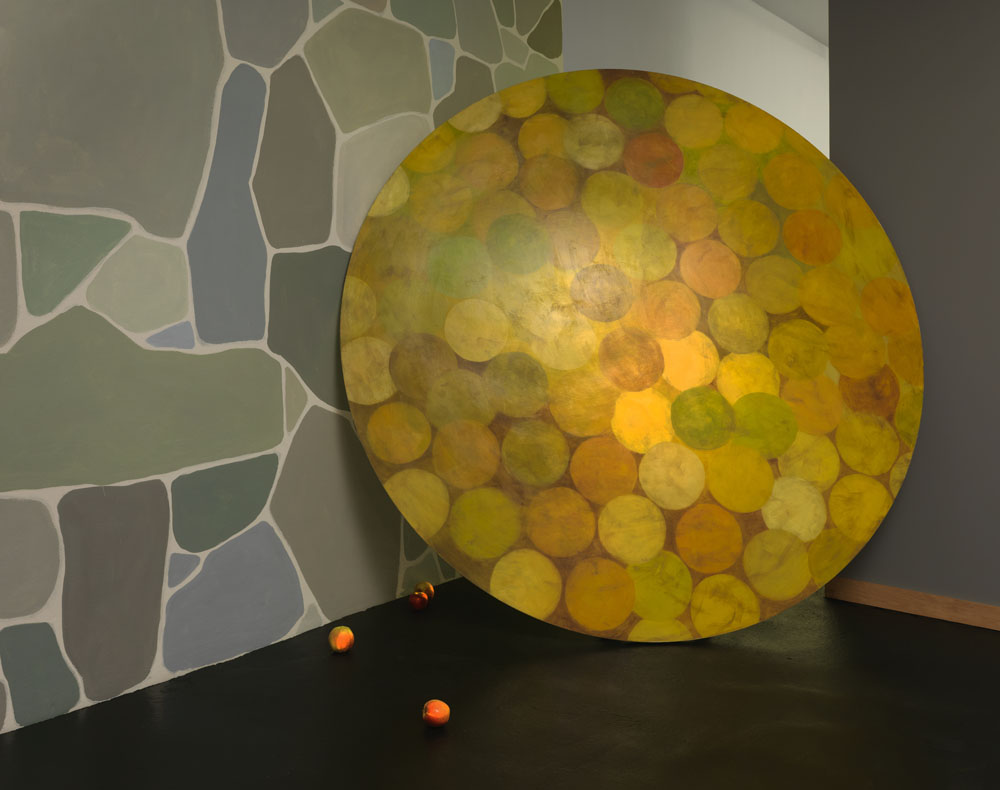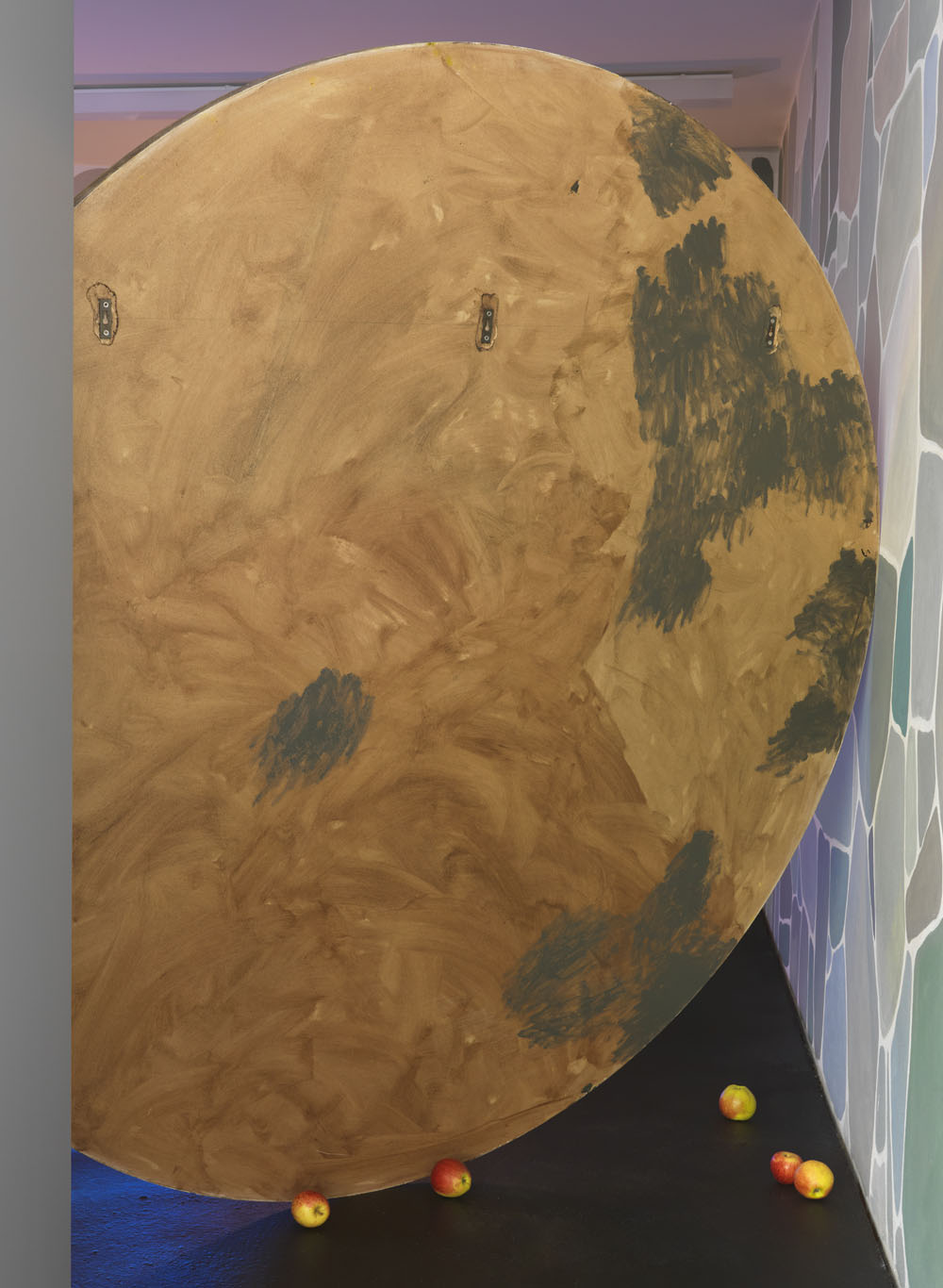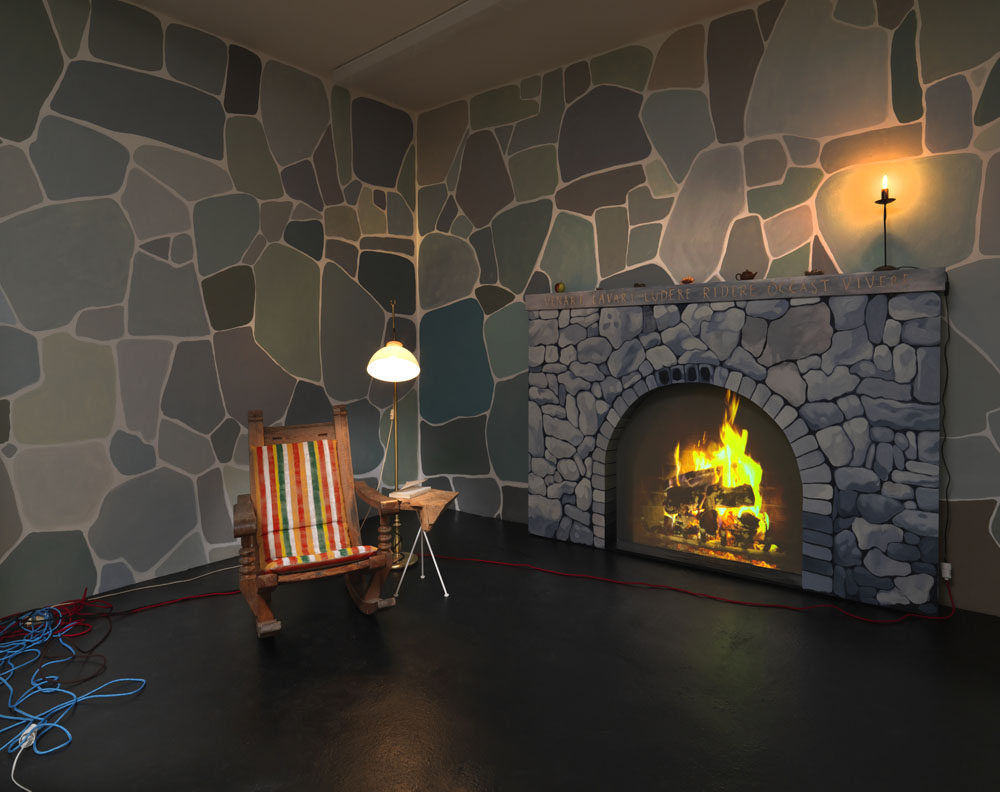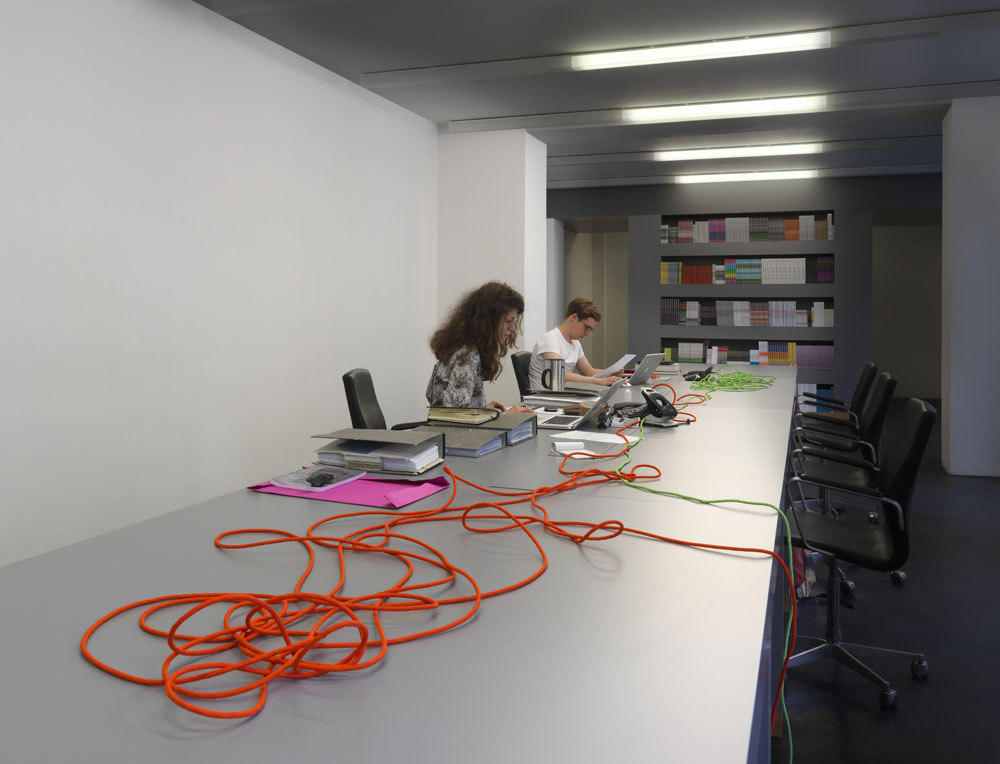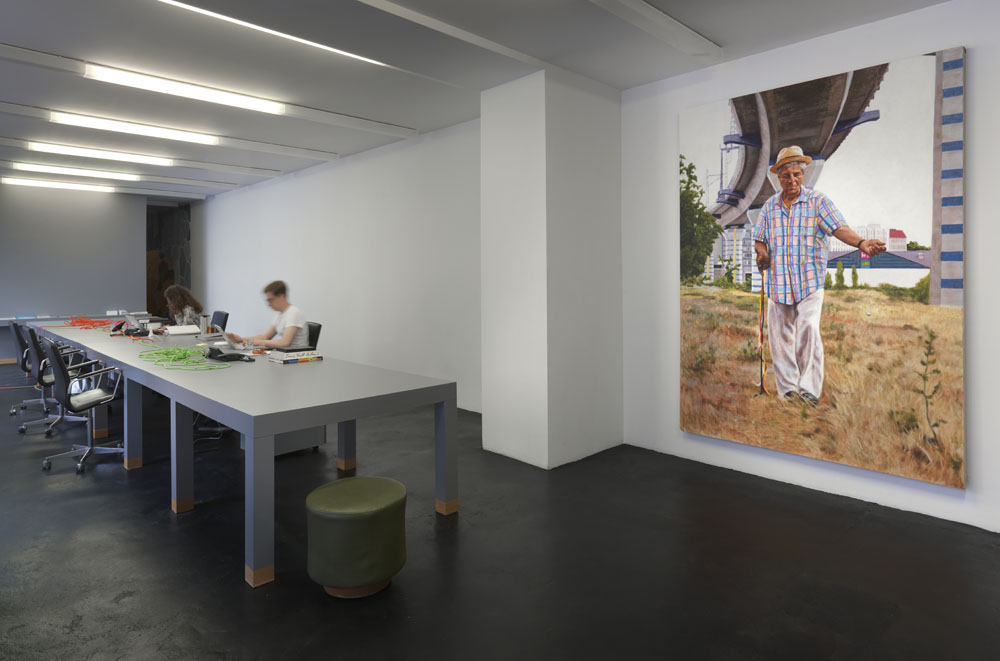The World of Gimel, 2009-
The guardian of all things that are the case, among others: a clay teapot in the form of a human hand, a shell, a pot made of fragrant wood, contains one black ball or two glass eyes, a buddha’s hand citron, a hedge apple, also called osage orange
Majewski’s World of Gimel revolves around a personal Universalmuseum, which consists of eight objects that are housed in a vitrine and guarded by a custodian, or The guardian of all things that are the case. Woven into these images and seven objects are stories, films, and threads of research that question the objects’ meaning, which Majewski keeps following since 2009 by traveling to each object’s place of origin. As it turns out, the question of the objects’ meaning actually has to do with man’s relationship to nature and the cosmos – and, in the end, life flows through each of these things.
Each of these objects emerges again in a painting: a nude woman peers inside a large shell in an ice-age landscape; the Gardener of mechanical objects sows metal seeds and waters them with the index finger of his teapot-hand in ribbons of color; a woman in Romanian dress presents a large, biomorphic sculpture – a Buddha’s Hand citron, a type of citrus fruit; a wooden pot with detailed grain sits in an undefined space – though the pot in the image remains shut, the title refers to its contents, a black ball or two glass eyes. A young woman carries the weight of a huge meteorite on her belly, while another young woman is entering a gigantic shell in a primordial landscape.
The Hedge Apple (also called the Osage Orange ) appears in two different installations. While Entity is an installation around a science-fiction story, in which the Hedgeapple appears to be a monadic object replacing all other objects, the other installation carries us back into the past when we sit down in the rocking chair next to the fireplace in VENARI LAVARI LUDERE RIDERE OCCAST VIVERE, a reconstruction of the self-build house of the writer John Joseph Mathews, who was observing the change of the seasons of his native ecosystem of Osage County. The fireplace room in the gallery becomes a kind of inhabitable painting, where one might have the chance to contemplate the oversized, abstracted Osage orange – or eat some apples. Colored wires connect the “space of images” with the “fireplace room” and deliver electricity for the latter’s electric fire and lighting.
Each of the objects is also questioned in conversation with other people, often in the countries of origin of the objects: in Senegal, China, Brazil, Germany, France and Poland. These conversations are often videos, sometimes text; and sometimes, they are an exchange using “art” languages. In the exhibition in Kunsthaus Graz, 2011, artworks by other artists were set in relationships to the objects. These artworks were not specifically made on invitation, but appeared along the way, and the connections seemed so strong that they “belonged” to the World of Gimel just as much as the artworks by Antje Majewski; reflecting her idea that art is not the production of artefacts, but a shared field in which thoughts, images and love are spun into a net.
The World of Gimel. How to Make Objects Talk
01.10.2011-15.01.2012
Curated by: Adam Budak, Antje Majewski
Artists: Antje Majewski, with Thomas Bayrle, Helke Bayrle, Marcel Duchamp, Didier Faustino, Pawel Freisler, Delia Gonzalez, Alejandro Jodorowsky, Edward Krasinski, Leonore Mau, Markus Miessen & Ralf Pflugfelder, Dirk Peuker, Agnieszka Polska, Mathilde Rosier, Gavin Russom, Issa Samb, Juliane Solmsdorf, Simon Starling & Superflex, El Hadji Sy, Neal Tait
The exhibition is designed by Didier Faustino / Mésarchitecture (Paris) . The alternative audioguide is composed and performed by experimental musician and writer Momus. Mathilde Rosier’s performance Cruising on the Deck will take place during the opening, performed by the guests of the vernissage. Events accompanying the exhibition include a lecture by Chantal Mouffe and Marcus Steinweg, as well as a screeing of films by Alejandro Jodorowsky and Djibril Diop Mambéty.
The alchemy of things is at the core of a multimedial project by the German artist, Antje Majewski (1968) which aims at rethinking the representation and meaning of objects in the form of a highly personal and quasi surreal collection. In other words, based upon the investigation of various museums and collections, including the profound research into the encyclopeadic structure of the 200-years old Universalmuseum Joanneum, her (private) collection of inanimate objects is the artist’s utopian and subversive (and a seemingly absurd…) take at how to make objects talk. Thus Majewski’s own private museum is a sort of language laboratory – a rhizomatic structure of multilayered connections, a hybride of babel and aleph which sums up an advanced museological experience as beyond-spiritual, universal and hyper semantics.
Realized within the pavilion-like architectural structure that combines painting, video, installation and a book, Majewski’s project refers to a variety of museum’s patterns, including the museum as a place of magical practices (such as, amongst others, a self-reassertion in regards of the current order of things), or the museums as a site of disrupture and cultural displacement regarding former or other orders and use of things. Systems of classifications / systematizations / symbolic orders are revisited through an almost hallucinatory process of questioning and question-posing, regarding the objects‘ ontologie(s):
If we multiply the stories around an object, could this reveal it’s thingness in the center? Could it be possible to grow inanimate things in your garden? Is it possible to replace all inanimate art objects by one living object? Is there really a difference between inanimate and animate objects? Can objects speak? Does all matter think? Can we create objects that connect their thinking with ours?
Thank you:
Adam Budak, Peter Pakesch, neugerriemschneider, all artists and writers, Clémentine Deliss, the objects
Texts:
Antje Majewski, News from the World of Gimel, 2011
Antje Majewski: Neuigkeiten aus der Gimel-Welt, 2011
See also:
The Guardian of All Things that are the Case. The Eight Objects, 2009-2011
The Guardian of All Things that are the Case, 2011
Antje Majewski: The guardian of all things that are the case, among others: a clay teapot in the form of a human hand, a shell, a pot made of fragrant wood, contains one black ball or two glass eyes, a buddha’s hand citron, a hedge apple, also called osage orange . neugerriemschneider (2011)
Catalogue:
Adam Budak, Peter Pakesch (Ed.), Antje Majewski, The World of Gimel. How to make objects talk. Kunsthaus Graz / Sternberg Press, 2011
Image slider title
